

45 Math Writing Prompts
As children work their way through the math curriculum, it’s important that they understand how to solve the material. However, it’s just as important that they are able to explain their steps and write about math.
By encouraging students to dive deeper into their understanding of math concepts, you will help them retain important information and think critically. Many teachers have taken to using journals as part of their math curriculum in order to help students get into a routine of learning, understanding, and then explaining.
Below, you’ll find a list of math-related writing prompts to get your class started on writing in a math journal.
Using This Guide
These prompts are fairly basic, which leaves room for you to alter them to match your class’s grade level and skill.
Here are a few ways you can use these prompts in your classroom:
- Keep these prompts handy for students to use if they finish their classwork early.
- Reserve part of your math period for journal writing, to help students think critically about what they’ve learned.
- Assign prompts by groups, and have students compare their answers.
The Writing Prompts
- Do you think math is fun? Why or why not?
- Write an acrostic poem using the word “DIVIDE”.
- List three careers that use geometry, and explain how it is used for each.
- Explain what you know about geometry.
- How do you feel when you hear someone say that math is fun? Explain.
- Where is one area you think you could improve in math? How can you work toward this goal?
- Why is it important to learn math using both equations and word problems?
- Give at least three examples of how you use math every day.
- Do you sometimes feel intimidated by math or math class? Explain.
- Write a word problem for someone in your class to solve.
- If math were a person, what would their personality be like?
- What is the process of multiplying a single-digit number by a two-digit number?
- Compare and contrast the concepts of multiplication and division.
- Write a word problem involving a garden.
- Explain what you know about subtraction.
- What is something that you’ve learned in math class recently?
- How do you feel when you finally understand a math concept? Explain.
- Write three ways you use fractions in everyday life.
- Write a short story about someone solving a math problem.
- How can your math teacher make the subject more interesting for your class?
- Think about these things: pizza, driving, shopping, and time. How does math connect to each of these things?
- How does multiplication make addition easier? Give examples.
- List three careers that involve math, and explain why math is essential to each.
- How is math used in sports? Give examples.
- Jot down 7-10 words that relate to math. Use these words to write a math-related poem.
- Write an acrostic poem using the word “MATH”.
- Use a Venn diagram to compare and contrast your classmates.
- What should you do if you don’t understand a math problem? Explain.
- What is something in math that you’ve learned this year?
- Today in math class, I learned…
- Write a story about a classmate who helps another classmate with math homework.
- Why is it important to keep practicing math over summer break?
- How do we use fractions in real life?
- Explain how to properly use a ruler or yardstick.
- Write MATHEMATICS at the top of your paper, and see how many words you can make from the letters.
- When I think about math, I think…
- Write an acrostic poem using the word “EQUATION”.
- Why is it important to learn how to do math problems on paper before you use a calculator?
- Create a graph using information about people or objects in your classroom.
- Do you learn better by watching someone solve a problem, or by listening and practicing the steps yourself?
- Prove that 3+9=12 using two different methods.
- Why is estimating a good way to solve a math problem?
- Compare and contrast squares and rectangles.
- Write a math problem about something in your classroom.
- Explain a good way to remember how to use the less than and greater than symbols.
Looking For More?
Our site is home to an abundance of academic resources, themed writing prompts, classroom forms, and so much more.
If you are looking for something specific and can’t find it, let is know! We’d love to help make your teaching journey a little easier.
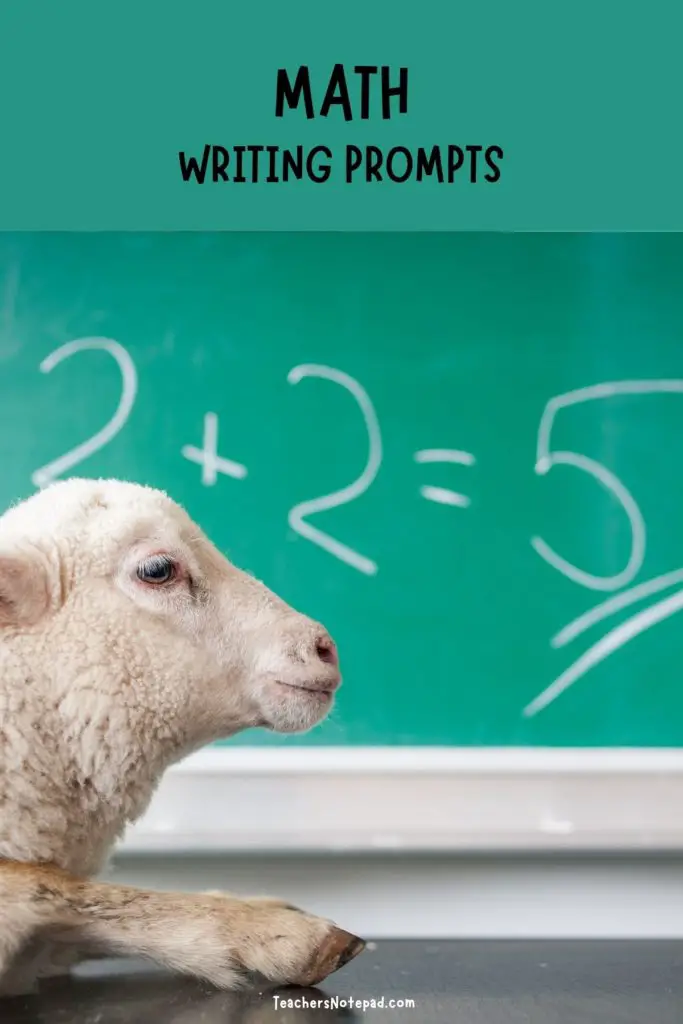

- Math for Kids
- Parenting Resources
- ELA for Kids
- Teaching Resources

How to Teach Long Division to Kids in 6 Easy Steps
15 Famous Mathematicians in History That Kids Should Know
11 Best Multiplication Apps for Kids
How to Teach Number Formation in 5 Easy Steps
13 Best Resources for Math Videos for Kids: Math Made Fun
6 Best Alternatives to Public Schooling: A Guide for Parents
How to Cope With Test Anxiety in 12 Easy Ways
Developmental Milestones for 4 Year Olds: The Ultimate Guide
Simple & Stress-Free After School Schedule for Kids of All Ages
When Do Kids Start Preschool: Age & Readiness Skills
How to Teach Letter Recognition in 6 Easy Steps
20 Fun Limericks for Kids
How to Improve Reading Comprehension: Strategies & Tips
40 Best Summer Writing Prompts for Kids of All Ages
12 Best Ways to Teach Rhyming Words to Kids
12 Best Tips for Substitute Teachers
30 Best Classroom Reward Ideas for Elementary Students
12 Best Websites for English Teachers
10 Best Game-Based Learning Platforms for Kids
60 Fun Animal Facts for Kids

31 Best Math Writing Prompts for Kids of All Ages
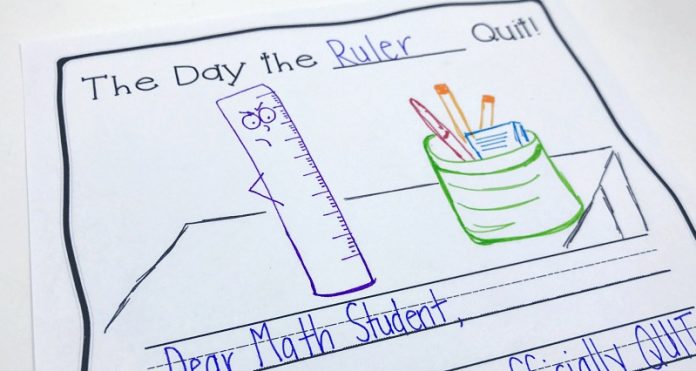
10 Best Math Writing Prompts For Kids (Grades 1-5)
10 math writing prompts for middle school children (grades 6-8), 11 math prompts for high school students (grades 9-12), how math writing prompts help students.
Mathematics is more than just numbers and equations; it’s a vital part of our education system that helps students develop critical thinking and problem-solving skills . But how can we make learning math more engaging and less intimidating? This is where creative math writing prompts come into play.
SplashLearn: Most Comprehensive Learning Program for PreK-5

SplashLearn inspires lifelong curiosity with its game-based PreK-5 learning program loved by over 40 million children. With over 4,000 fun games and activities, it’s the perfect balance of learning and play for your little one.
Math writing prompts are unique tools that blend the world of numbers with the art of words. They are about solving problems explaining concepts, exploring ideas, and expressing thoughts in written form. This approach makes math more relatable and interesting for students of all ages.
Educators can transform how students perceive and interact with mathematics by integrating these prompts into math lessons . It’s not just about finding the right answer anymore; it’s about understanding the ‘why’ and ‘how’ behind it.
Looking for a way to make math engaging and fun for your students? SplashLearn offers a world of interactive math games that turn challenging concepts into exciting adventures. From basic addition to complex algebra , we have something for every learner.
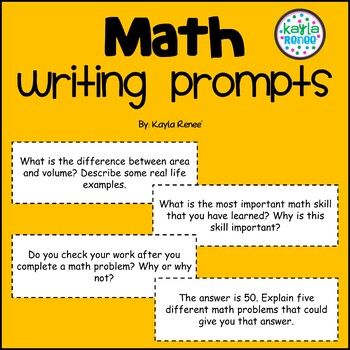
1. Reflect on a Math Challenge: Think about a time when you faced a difficult math problem. How did you solve it? What did you learn from this experience?
This prompt encourages students to reflect on their problem-solving skills and resilience in mathematics. It helps them recognize their growth and learning process in the subject.
2. Math in Everyday Life: Write about how you use math daily. Give specific examples, like shopping, cooking, or planning a trip.
This exercise helps students see the practical applications of math, making the subject more relevant and interesting to their everyday experiences.
3. Your Math Hero: Who is your math hero (it could be a teacher, a famous mathematician, or someone else) and why do they inspire you?
By identifying a math hero, students can explore different aspects of mathematics and its impact while also finding personal inspiration and role models in the field.
4. Math and Future Dreams: How will math be important in your future career or life goals?
This prompt encourages students to connect math with their future aspirations, highlighting the subject’s importance in a wide range of fields and personal ambitions.
See how math shapes the future! Join SplashLearn for games that make learning math fun and relevant.
5. Dream Math Teacher: Imagine you could design your dream math teacher. What qualities would they have? What kind of math games or activities would they do with the class?
Imagining a dream math teacher allows children to think about the qualities that make learning enjoyable and effective. This prompt fosters creativity and provides insights into how they prefer to learn and engage with math.
Create your dream math learning experience with SplashLearn’s engaging games and activities.
6. Math and Creativity: Do you think math can be creative? Give examples of how creativity is used in solving math problems.
This prompt challenges the stereotype that math is purely analytical, encouraging students to see the creative aspects of problem-solving in mathematics.
7. A New Math Concept: Describe a new math concept you learned recently and how it has changed your perspective on math.
Reflecting on recent learning helps students consolidate their knowledge and appreciate the evolving nature of their understanding of math.
8. Math and Sports: Choose your favorite sport and write about how math is used in it. Think about scoring, measuring distances, or calculating averages.
Linking math with sports helps children see the practical applications of math in areas of interest. It demonstrates how math is theoretical and a vital part of activities they enjoy and understand.
9. Your Favorite Math Topic: What is your favorite topic in math and why? Explain what makes it interesting to you.
Encouraging students to identify and articulate what they enjoy about math can enhance their engagement and interest in the subject.
10. Building with Geometry: If you could build anything with geometric shapes, what would you build and why?
This prompt encourages kids to use their knowledge of geometric shapes in a practical, creative task. It helps them understand the role of geometry in design and construction, fostering both creativity and spatial awareness.
Art and geometry are a perfect pair. Delve into the geometric beauty of art and shape with fun games.
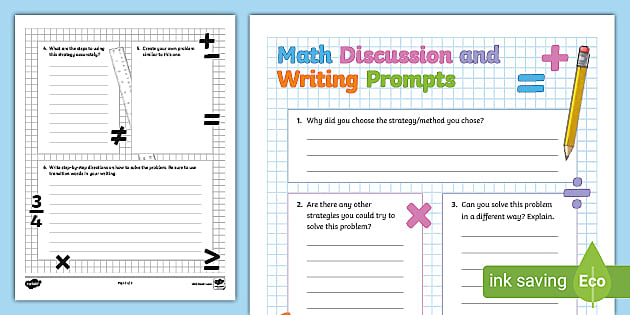
11. Math in Nature: Explore how math is used in nature. Write about patterns, symmetry, or shapes you find.
This prompt encourages students to observe and explore the natural world through a mathematical lens, focusing on patterns , symmetry , and shapes . It helps them understand the omnipresence of math in the environment.
12. The Algebra of Everyday Life: How do you use algebra daily? Give examples.
Students are encouraged to identify and articulate how algebra is used in daily activities. This prompt helps them connect abstract mathematical concepts with real-world applications.
Apply algebra in real life with engaging games. Solve Real-Life Problems Now!
13. Math in Cooking: If you have helped in the kitchen, think about how you use math in cooking or baking. Write about an experience where you used measurements or fractions.
This prompt helps children understand the importance of measurements and fractions in cooking, showing math’s role in everyday tasks. It’s a practical way to apply mathematical concepts in a fun, engaging setting.
14. A World Without Zero: Imagine a world where the number zero does not exist. How would things change?
Imagining a world without the number zero challenges students to think about the fundamental role of this number in mathematics and everyday life. It enhances their understanding of the number system .
15. Building with Math: Think about being an architect or a builder who uses math daily. Write about a dream building or structure you would like to design. How would you use math to plan and build it?
This prompt helps children understand the importance of math in architecture and construction. It encourages practical and creative thinking, showing how math is essential in designing and building structures.
16. The Biography of a Mathematician: Write a short biography of a famous mathematician.
Writing a mathematician’s biography allows students to explore the history of mathematics and the contributions of individuals to the field, fostering a deeper appreciation and context for mathematical concepts.
17. If I Were a Math Problem: If you were a complex math problem, what would you be and why?
This creative prompt encourages students to think abstractly and metaphorically about mathematics, fostering a deeper, more personal engagement with mathematical concepts.
18. Math in Music: Explore the relationship between math and music.
Exploring the relationship between math and music helps students understand rhythm, scales, and patterns in music, highlighting the interdisciplinary nature of math.
19. The Future of Math: Predict how math will change in 50 years.
Predicting the future of math encourages students to think critically about the evolution of mathematical concepts and technology, fostering forward-thinking and innovation.
20. Math in Space: Astronauts use math in space. Write about how you think they use math on the International Space Station or when exploring other planets.
By exploring how astronauts use math, this prompt expands a child’s understanding of math’s role in science and technology. It also encourages them to think about math in innovative and advanced applications.
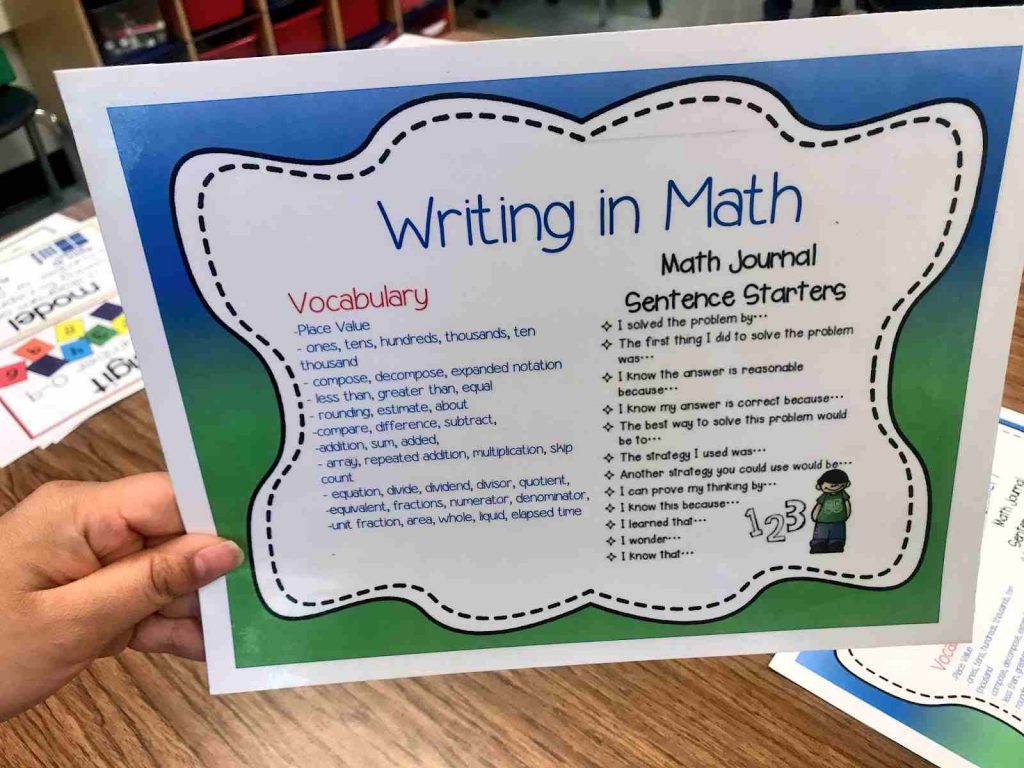
21. The Philosophy of Numbers: Discuss the philosophical aspects of numbers and their existence.
This prompt encourages students to delve into numbers’ abstract and philosophical aspects, exploring their existence beyond practical applications. It fosters critical thinking about the foundational elements of mathematics.
22. Math in Architecture: Explore how math is essential in designing buildings.
Students explore the integral role of math in architecture, understanding how geometric and algebraic concepts are essential in building design. This prompt bridges the gap between mathematical theory and practical construction.
23. Advanced Algebra in Real Life: Identify real-life situations where advanced algebra is applicable.
This exercise challenges students to identify and articulate the application of advanced algebra in everyday scenarios. It helps them recognize the relevance of complex algebraic concepts in real-world contexts.
24. The Role of Calculus in Medicine: Discuss how calculus is used in the medical field.
Discussing the use of calculus in medicine allows students to see the practical applications of this advanced mathematical field, particularly in areas like medical imaging and disease modeling.
25. Statistics in Society: Analyze how statistics affect decision-making in society.
This prompt encourages students to analyze the role of statistics in societal decision-making, highlighting its importance in areas like public policy, economics, and social sciences.
26. Math and Environmental Challenges: Write about how math helps solve environmental issues.
Students are prompted to explore how mathematical models and calculations are used to address and solve environmental issues, emphasizing the role of math in ecological conservation and sustainability.
27. The Economics of Math: Explore the role of math in economics and finance.
This topic allows students to investigate how mathematical principles underpin economic theories and financial practices, highlighting the quantitative aspects of economics and finance.
28. Coding and Math: Discuss the relationship between coding and mathematical concepts.
Discussing the relationship between coding and math helps students understand the mathematical foundations of computer programming and the importance of logical reasoning in technology.
29. Math in Space Exploration: Explore how math is crucial in space travel and exploration.
This prompt encourages students to explore the crucial role of mathematics in space travel and exploration, from trajectory calculations to spacecraft design.
30. The Logic of Math: Discuss the importance of logic in mathematics and its applications.
Students discuss the role of logic in mathematics, understanding its importance in developing mathematical proofs, problem-solving, and the overall structure of mathematical reasoning.
31. Math and Artificial Intelligence: Write about math’s role in AI development.
Writing about the role of math in AI development allows students to explore the intersection of mathematics, computer science, and technology, highlighting the importance of algorithms and statistical models in AI.
1. Enhancing Problem-Solving Skills: Math journal prompts are more than just a way to practice math ; they’re a gateway to developing advanced problem-solving skills. When students write about math problems , they learn to approach these problems from different angles. This practice helps them think critically and find various solutions to a single problem, enhancing their ability to tackle complex challenges.
2. Encouraging Creative Thinking in Math: Creative thinking is as crucial in math as it is in any art form. Math prompts encourage students to use their imagination to explore mathematical concepts. This approach helps them see math as a set of rules to follow and a field full of possibilities and creative solutions.
3. Improving Mathematical Communication: Communicating complex mathematical ideas can be challenging. Math prompts help students articulate their mathematical thoughts clearly and concisely. This practice is essential for students to effectively share their ideas and understandings, whether in a classroom discussion, a written report, or even in future careers requiring mathematical knowledge.
4. Bridging the Gap between Math and Literacy: Often, students see math and literacy as two distinct areas with little overlap. However, math prompts help bridge this gap. Students improve their literacy skills by writing about math while deepening their mathematical understanding. This integrated approach shows students the interconnectedness of different subjects and enhances their overall academic skills.
In conclusion, using math writing prompts offers a unique and effective way to engage students in mathematics. By enhancing problem-solving abilities, fostering creative thinking, improving communication skills , and bridging the gap between math and literacy, these prompts not only make math more accessible but also more enjoyable.
Ready to make math a thrilling adventure for your students? Join SplashLearn today and transform the way kids learn math.
Frequently Asked Questions (FAQs)
What are math writing prompts.
Writing prompts for math are questions or statements that inspire students to think and write about mathematical concepts. They encourage a deeper understanding of math by integrating writing and critical thinking skills, making math more engaging and accessible.
How often should teachers use math writing prompts?
Teachers can use math prompts as often as they see fit, ideally once or twice a week. Regular use helps students develop a habit of thinking critically about math, but it’s important to balance them with traditional math exercises.
Can math writing prompts be used for assessment?
Yes, math prompts can be an effective tool for assessment . They allow teachers to evaluate students’ mathematical understanding and ability to communicate and reason, providing a more holistic view of their learning.
- Pre-Kindergarten
- Kindergarten
Most Popular

15 Best Report Card Comments Samples

117 Best Riddles for Kids (With Answers)

40 Best Good Vibes Quotes to Brighten Your Day
Recent posts.

15 Best Fourth of July Crafts for Preschoolers

Math & ELA | PreK To Grade 5
Kids see fun., you see real learning outcomes..
Watch your kids fall in love with math & reading through our scientifically designed curriculum.
Parents, try for free Teachers, use for free

- Games for Kids
- Worksheets for Kids
- Math Worksheets
- ELA Worksheets
- Math Vocabulary
- Number Games
- Addition Games
- Subtraction Games
- Multiplication Games
- Division Games
- Addition Worksheets
- Subtraction Worksheets
- Multiplication Worksheets
- Division Worksheets
- Times Tables Worksheets
- Reading Games
- Writing Games
- Phonics Games
- Sight Words Games
- Letter Tracing Games
- Reading Worksheets
- Writing Worksheets
- Phonics Worksheets
- Sight Words Worksheets
- Letter Tracing Worksheets
- Prime Number
- Order of Operations
- Long multiplication
- Place value
- Parallelogram
- SplashLearn Success Stories
- SplashLearn Apps
- [email protected]
© Copyright - SplashLearn

Make study-time fun with 14,000+ games & activities, 450+ lesson plans, and more—free forever.
Parents, Try for Free Teachers, Use for Free
You are using an outdated browser. Upgrade your browser today or install Google Chrome Frame to better experience this site.
- Professional learning
Teach. Learn. Grow.
Teach. learn. grow. the education blog.

4 ways to engage students with writing in math class

My first classroom position was teaching sixth-grade science at an elementary school. I had a great curriculum with a lot of hands-on exploration of phenomena that both my students and I loved. The one thing missing, though, was a real reading and writing component. So, I created an introductory unit on science writing. It involved teaching students explicitly how to make and record detailed observations and clearly explain the rationale for their inferences. I worked with the school librarian to get access to age-appropriate science magazines and had students read and respond to articles regularly. As someone who loves to write, it made sense to me to incorporate writing into all areas of the classroom.
I brought this interest in content-area writing along when I transitioned to teaching third grade. That curriculum had plenty of opportunities to write in science and social studies. However, I noticed that beyond the typical “Explain how you solved the problem” prompts, there was very little writing in math. When I excitedly asked my new grade-level colleagues if they used math journals, they looked at me as if I had spoken to them in another language. The idea of writing in math seemed somewhere between unnecessary and ridiculous to them.
Thankfully, teachers have become much more open to writing in math class since then. NCTM’s 2000 publication “Principles and standards for school mathematics” helped drive this connection by including communication as a key component of mathematics learning. NCTM framed mathematical communication as “a way of sharing ideas and clarifying understanding. Through communication, ideas become objects of reflection, refinement, discussion, and amendment. When students are challenged to communicate the results of their thinking to others orally or in writing, they learn to be clear, convincing, and precise in their use of mathematical language.” Since this publication, most college-and-career ready standards have incorporated the need to communicate mathematical ideas into their math practice standards.
Why is writing in math class important?
The act of writing involves examining, organizing, reconsidering, and synthesizing one’s ideas. Writing is a “knowledge transforming” process that involves both the retrieval and encoding of ideas and concepts in our memory. As stated in the NWEA stances on writing , “Writing is a cognitive, nonlinear process that serves as a tool for learning and critical thinking, stimulating the writer to think more deeply about a text, topic, or concept. In this way, writing doesn’t just show thinking; it is thinking, and it is an essential practice across disciplines.”
Research has demonstrated the impact of writing in furthering mathematical understanding. A 2020 meta-analysis of research on writing in the content areas of math, science, and social studies showed that writing to learn in each of these subject areas “reliably enhanced learning” with an effect size of 0.30. Another meta-analysis focused on writing specifically in math found an even greater effect size of 0.42.
Writing in math class can both uncover and potentially improve students’ attitudes toward the subject. A 2014 study involving students with high math anxiety found that when students wrote expressively about their thoughts and feelings prior to an exam, the difference in performance between low and high math anxiety students was significantly reduced relative to the control group in which students did not engage in pretest expressive writing.
There’s more than one write way
At a high level, there are two different ways to think about writing in the math classroom. One way is a writing-first approach, where the focus is on improving student writing, and math is a topic that is used to support this. The other approach is math-first, where writing serves as a tool for helping students learn and integrate mathematical content.
Naturally, with a writing-first approach there is more emphasis on drafting, revising, and honing writing. In a math-first approach, which will be the focus of this article, revisions are less common. While students should be taught and coached on how to articulate mathematical ideas and arguments clearly, revisions are more about recording shifts in students’ thinking about the mathematical content than they are about mechanics or style.
Within the math-first approach, there are many ways to incorporate writing in math class. I’ll dig into four of them here.
1. Eliciting impactful explanations
Let’s start by examining the aforementioned “Explain how you solved the problem” prompts found in many teaching materials.
You are likely familiar with the tepid and uninformative responses these questions can elicit if students are not taught how to unpack their mathematical thinking. Without coaching and modeling, students are likely to simply list the series of steps they took to solve the problem, rather than explain why they chose that approach, identify challenges they encountered and decisions they made along the way, and say how they determined their answer was reasonable. Just as I had done when teaching science, I realized I needed to explicitly teach my students to explain how they approached and solved a problem. This instruction went hand in hand with developing a classroom culture where students felt comfortable explaining their thinking orally, asking and answering questions of one another, and defending their mathematical thinking.
To start, when solving a problem, I would model my own mathematical thinking on chart paper. I did this in a double journal entry style, solving part of the problem on one side of the paper and then recording my thoughts and decisions on the other side. Capturing decisions, missteps, mistakes , and course changes is a great way to model the math practices , particularly making sense and persevering in problem-solving. It is also a great way to model that the problem-solving process may not always be linear and that mistakes are normal and can lead to deeper understanding.
Writing in math class can both uncover and potentially improve students’ attitudes toward the subject.
After I finished, I would allow students to ask questions about what I wrote and I would use this to add to my writing, or I would annotate what to include next time. As students started writing on their own, I would share less-than-exemplary examples that I had created, alongside high-quality student examples. First as a whole class and then later in pairs, students would highlight the differences between the pieces and we would annotate the poor examples to show how to improve them. This included sharpening mathematical vocabulary, discussing models that could support the written text, and adding details for clarity. Finally, as students gained more confidence in their writing, I would pair students who solved the same problem using different approaches. The students would read each other’s explanation and then ask questions to help clarify the other student’s writing. Because these were not formal writing pieces, students didn’t necessarily need to rewrite their explanations; however, they at least needed to take notes of what might help make their explanations clearer next time.
The power of connecting writing and problem-solving was well summed up by the authors of “Aiming for understanding: Lessons learned about writing in mathematics” : “Writing during problem-solving instruction was introduced to help us assess our students’ thinking, but…we concluded that writing about problem solving and reading others’ thoughts…actually helped our students develop a deeper understanding of the problem-solving process. What began as an assessment tool was now being recognized as an instructional tool. We were beginning to view writing as integral to the teaching of mathematics concepts.”
2. Providing a formative foundation
Mathematical writing can be a rich vehicle for formative assessment , and it can be employed before, during, or after a lesson or unit. For example, before starting a unit on fraction addition, you might assign a 5–10 minute quick write in which students record everything they know about fractions. Reviewing the writing can give you more insight into student understanding than a quiz, which is inherently limited in terms of content included. The knowledge you uncover about your students can help you tailor interventions and small- and large-group lessons to where students are in their conceptual understanding of fractions. The process of recall leverages spaced retrieval practice , which helps with long-term retention of information. Recalling related past concepts also primes students to connect previous content to new content, a topic I’ll discuss in the next section.
During the lesson, you can convert the traditional “Think, Pair, Share” activity into a “Think, Write, Pair, Share” activity. The writing can be done either on individual whiteboards or in a notebook, if you’d like to save the students’ writing. Adding writing to this protocol can give students more time to process their thinking. Additionally, if the writing is recorded in a journal, later in the unit students can be asked to reread earlier entries to reflect on how their thinking has changed or deepened.
Finally, end-of-lesson quick writes where students record the three most important things they learned, identify and define key vocabulary in their words, or comment on a particular student’s explanation or response can serve both as an assessment of student learning and a way for students to synthesize their new knowledge.
3. Making connections
Despite how many of us were taught it, mathematics is all about connections. Connections, along with communication, is one of NCTM’s five process standards . Students at all levels should be able to recognize and “understand how mathematical ideas interconnect and build on one another to produce a coherent whole” as well as how they connect to the wider world. I discussed why making connections is so critical in “Maximum impact: 3 ways to make the most of supplemental content.” Math journals and writing prompts are a great way to have students look for connections among concepts.
Varying degrees of scaffolding can be used to help students make connections. You can directly ask them to do a quick write that compares two concepts, such as multiplying whole numbers and multiplying a fraction and a whole number. Or, prior to starting a new unit, students could be asked to write down everything they know about a concept related to the upcoming unit. For example, if students are starting a unit on multiplication, you can ask them to write everything they recall about arrays. As you move through the unit, you can ask questions to explicitly help them see the connection between arrays and multiplication.
You also want to provide prompts that allow students to find their own connections between concepts. Having students create concept maps is a great way to have them show connections between concepts. Simple sentence starters or sentence frames like “Division reminds me of…” or “Volume is similar to ______ because ______. Volume is different from ______ because ______” give students the freedom to make their own connections. In their article about improving writing prompts in mathematics , authors Craig Sjoberg, David Slavit, and Terry Coon share a simple three-part prompt to help students make mathematical connections:
- Explain at least one thing you learned in math this week.
- How does your answer connect to other mathematical ideas?
- How do these ideas connect to the real world?
4. Supporting metacognition
In addition to all the ways to have students share their mathematical understanding, I also liked to use math journals as a means of reflection. Students can be prompted to consider how they engaged with an activity or a discussion, reflecting on what helped to move their thinking along, what may have confused them, and more. This can help them understand how they learn best.
Metacognition, or the awareness and regulation of your own thought processes, is a key component to creative problem solving (as opposed to rote following of procedures). There are several ways to incorporate this type of reflection into math class:
During a lesson
If you have students take notes in class, you can teach them to engage in note-taking/note-making activities where they write the main idea on one side of the paper and their thoughts, reactions, and connections on the other side of the paper.
After a lesson
Have students respond to one of the following prompts:
- Did you have any lightbulb moments during that lesson? What led to that moment?
- Is there anything that is still confusing to you?
- What did you know or think about this topic before today? How has your understanding changed?
- How might you have presented this topic to someone else?
- Did you need more time to work today? Was the activity too long or just right?
At the end of the week or at the end of the unit
Ask students to reflect on specific activities, lessons, or conversations they engaged in:
- Which one was the most interesting to you?
- Which one helped you understand something better? What did it help you understand better and why?
- Which one changed your thinking about a mathematical idea?
- Did any confuse you or leave you with new questions?
The wide world of mathematical writing
I have touched on only a few ways to think about writing in math class. Thankfully, there is an abundance of resources to help you explore a wide variety of ways to get your students writing about math. Here are just a few of them.
- “5 ways to use writing in the disciplines to support learning” This Learn. Grow. Post delves into ways to infuse writing in all content areas.
- “Writing in math” This article by Marilyn Burns provides examples of how to integrate writing in math class.
- Using writing in mathematics to deepen student learning This guide discusses the research supporting writing in math, explores different approaches to math writing, and provides prompts and samples of student writing.
- “8 ways to pose better questions in math class” Although the focus of this article isn’t strictly on writing, the tips and prompts provided can be applied to writing.
- “Integrating writing and mathematics” This Reading Rockets article shares multiple strategies and examples of student writing in math class.
- “Write on” This NCTM article discusses four categories of mathematical writing and provides prompts for each type.
- “Talking, writing, and reasoning: Making thinking visible with math journals” This Read Write Think lesson models how to incorporate journals into math activities and includes prompts designed to uncover students’ attitudes and dispositions toward math.
- “Journal prompts for elementary students” This resource contains three pages of math writing prompts.
Recommended for you

3 non-negotiables for differentiation in the math classroom

That’s not how I learned it! 4 ways to help your child with “new math”

Mapping math: 5 ways to use concept maps in the math classroom

Helping students grow
Students continue to rebound from pandemic school closures. NWEA® and Learning Heroes experts talk about how best to support them here on our blog, Teach. Learn. Grow.
See the post

Put the science of reading into action
The science of reading is not a buzzword. It’s the converging evidence of what matters and what works in literacy instruction. We can help you make it part of your practice.
Get the guide

Support teachers with PL
High-quality professional learning can help teachers feel invested—and supported—in their work.
Read the article
STAY CURRENT by subscribing to our newsletter
You are now signed up to receive our newsletter containing the latest news, blogs, and resources from nwea..
- Skip to main content
Join All-Access Reading…Doors Are Open! Click Here
- All-Access Login
- Freebie Library
- Search this website
Teaching with Jennifer Findley
Upper Elementary Teaching Blog
10 Ways to Get Students Writing in Math
Writing in math is more common and important in the elementary years than ever before. When I was in school, I barely remember writing more than a sentence in math class. Now, students are required and expected to write several sentences and even paragraphs explaining their math and justifying their answer . This can definitely be tricky as many students still think writing doesn’t belong in math. I want to share with you TEN ways to get your students writing in math on a regular basis.
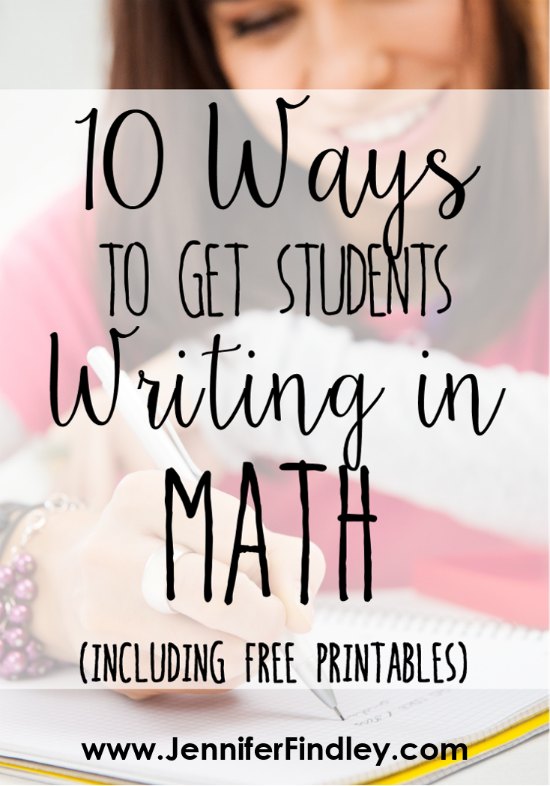
1. Model how to write in math.
Just the same way as we model a new think alouds in reading or a new writing strategy, we should also model writing in math. I like to do this through a problem of the day, using these steps:
- Read the problem together and circle key information (not key words – read more about why key words are not helpful in upper elementary here ).
- Discuss the situation of the problem and ensure all students have an access point.
- Allow the students a few minutes to work on the problem independently.
- Monitor the students while they are working and note any misconceptions or great thinking points.
- Remind the students that when they have solved the problem that they are to prove their answer is correct or explain how they got it.
- Come back together as a class and solve the problem together, calling on students to help you (this is where the monitoring helps- you can specifically jot down students that you want to call on).
- As a class, write the answer, explain the math that was used and why, and justify that the answer is correct.
2. Have partners share their ideas before writing.
One of the reasons many students are hesitant to write in math is because they are not confident with what they will say or are not sure how to put their thoughts in words. I like to have my students share their thoughts with partners before writing them down. This oral rehearsal before they write helps them get their thoughts straight in their head. It also provides a scaffold as their partner is able to scaffold them or ask questions for clarification.
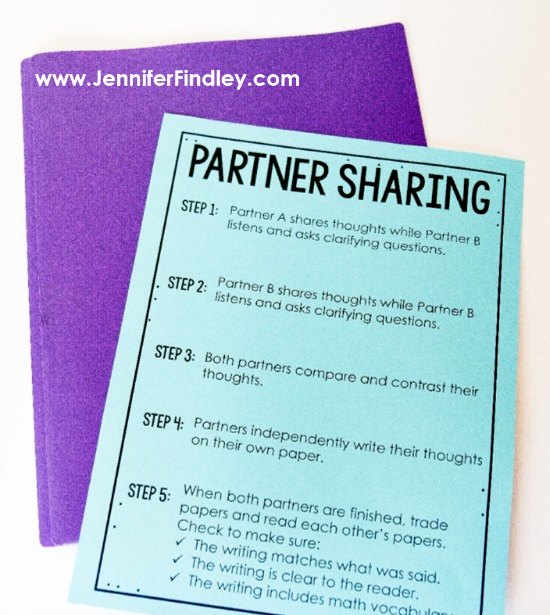
3. Use Constructed Response Tasks
The easiest way to get students to write more in math is to provide them with more opportunities for writing on a consistent basis. Instead of giving equations or multiple choice word problems as practice all the time, try giving constructed response tasks.
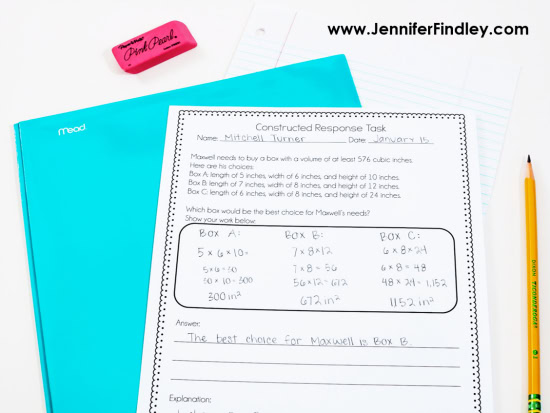
I use these constructed response math tasks that I created specifically aligned to my standards (common core). They require the students to answer the question and explain their answer. These work as extra practice and even assessments. You can see the 4th grade ones by clicking here and the 5th grade ones by clicking here .
4. Gallery Walks
My students love gallery walks because they incorporate movement and peer collaboration. They are also a perfect way to get students writing more AND reading and analyzing other students’ writing. Follow these steps:
- Set up tasks around the room written on anchor charts.
- In groups, have the students solve, explain, and justify their answers on a recording sheet or piece of paper.
- As the students are solving the tasks, walk around and choose one group for each task. This group will complete their work on the chart when all groups have worked the problems.
- Have the assigned groups solve the tasks, explain their answers, and justify their math on the chart.
- Do one final walk-through, allowing all the groups to analyze the students’ work on the charts, compare it to their own, and add to it.
Want to see this in action? Click here to read my blog post from a couple of years ago with examples and more details about how to implement a gallery walk in your classroom.
5. Use sentence stems.
I am a huge fan of using sentence stems to provide support to students in all areas of the curriculum even in the upper grades. Sentence stems can easily be provided for math instruction as well. With those stems, the students will have a scaffold to explain their thinking. Click here to read a post with the sentence stems I use to help my students justify their answers in math.
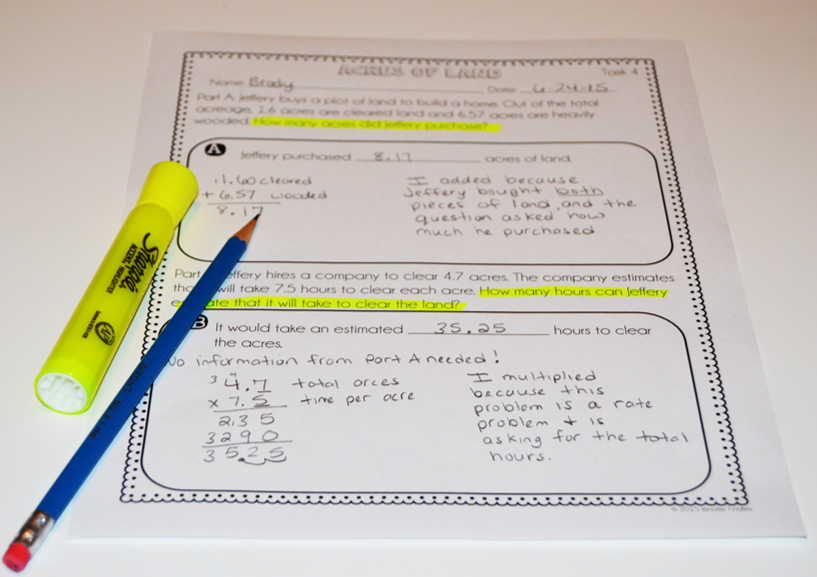
In addition to using generic sentence stems, I also use math tasks that have specific stems for the particular task. I use my multi-part word problems that are differentiated with a level that includes sentence stems. The sentence stems are helpful in getting the students used to writing their answers in complete sentences. They are also helpful in providing models for how to turn questions into sentences. Click here to check out the bundle of Multi-Part Word Problems in my TpT store.
6. Provide a structure or acronym to help students record their work.
Five years ago was when the shift to constructed responses and open ended questions first really started to drive my assessments and instruction. My students were not used to this. When they were given a word problem, they would work out the math and then just leave the math on the paper. They didn’t even circle the answer. I knew I needed to come up with something and fast. That was when I created a structure to help the students remember how appropriately answer word problems. This structure has made all the difference with their writing in math. My students use the acronym LOVE to help them ensure they have adequately answered a word problem and written support. Here is the breakdown of LOVE:
- L – Label – all numbers and models should be clearly labeled.
- O – Our Thinking – this is where the writing comes in. The students write the answer in a sentence and their explanation and justification.
- V – Visuals – the students include a visual to support their answer.
- E – Equation – the students ensure they have all the equations included.
To read more about this strategy, grab a poster, and some free word problems, click here.
7. Use math journals and math prompts.
This is probably one of the easiest ways that you can get students writing more in math. You can use journal or prompt writing as a warm up for the math lesson or even as a separate station. There are two main types of math journal prompts I use: Grade-Level/Skill Specific Prompts and General Math Prompts.
Grade-Level/Skill Specific Prompts
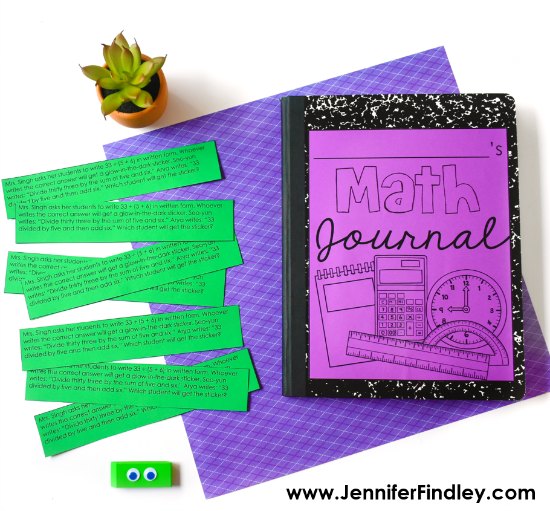
These type of prompts are specific to the skills I am teaching. They are perfect for:
- Checking for understanding
- Deeping students’ understanding in math
- Providing practice with using academic vocabulary in math
You can see my 5th Grade standard specific math journal prompts by clicking here or on the image above.
General Math Prompts
In addition to the skill-specific prompts, I like to also have my students write about math in general, math processes, and how they think about math. To do this, I primarily use my Math Practice Prompts. These prompts specifically target the Common Core Math Practice Standards. I sprinkle these in throughout the year when they best align to the skills I am teaching and what I see my students need.

FREE Math Practice Standards Prompts
Join my email list to get the Mathematical Practice Journal Prompts for Grades 3-5 for FREE!
Success! Now check your email to grab your freebie!
There was an error submitting your subscription. Please try again.
More Math Prompts – Reflection Spinner
In addition the journal prompts, you could also use generic prompts for the students to select from after solving a math task or math word problem. This spinner with generic prompts would be a perfect extension to any center. The students solve the problem, spin the spinner for a prompt, and then write to the prompt.
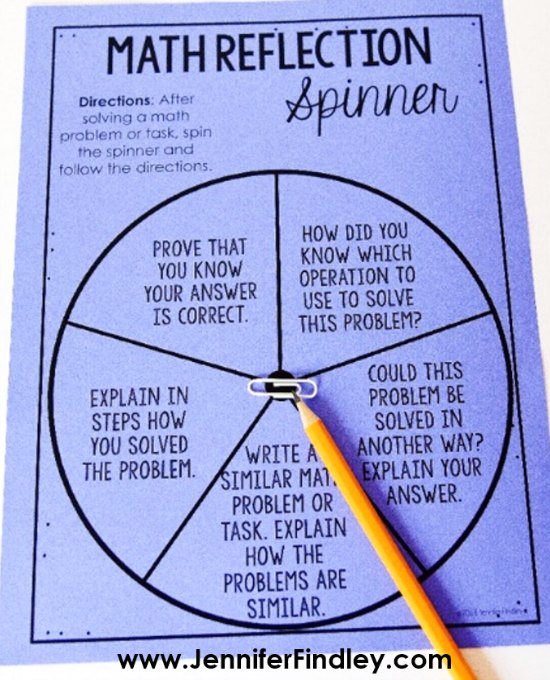
Click here to download the spinner for FREE.
8. Use “3 Minute Concept Writing” activity.
Similar to journal writing, this strategy is a great way to get students writing in math and a great way to assess their knowledge of a concept. On a weekly basis, I like to give my students a math concept and have them write for 3 minutes about everything they know about the concept. This strategy has two purposes – it gets them writing and it gives yo a glimpse into their thinking. You can do this before you teach a skill as a pre-assessment, in the middle of a unit to check their mastery and determine how to proceed through the rest of the unit, or at the end of a unit as a summative assessment. Click here to grab a template to use . Simply print the page, write in the math concept or idea, and make your copies.
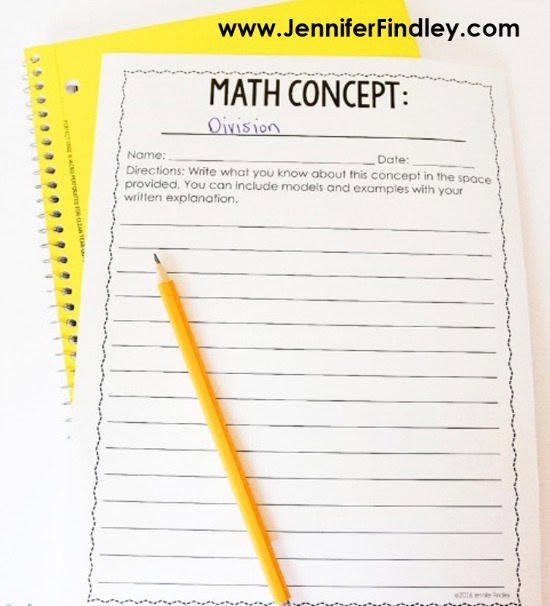
9. Read math read alouds and have the students write.
Math read alouds can be very engaging to the students and a great way to get some writing in. As you read the picture book, ask the students questions and have them defend their answers with explanations that include math and details from the read aloud. They will love this so much that they will forget they are even doing so much math and writing.
10. Integrate math into writing instruction.
Math is the least often integrated skill into literacy. We easily integrate science and social studies. If you want your students to write more in math, try integrating math into your writing instruction. Here are a few ideas:
- When teaching how-to writing, have your students choose a math procedure or skill and write a paper about how-to do the math. This can be done several times with new math skills.
- When teaching narrative writing, have the students write about a day without math. I recommend doing a brainstorming chart before hand to scaffold them.
- When teaching opinion writing, the students can write opinions on different math skills they have learned – which is easiest to learn, which is the most difficult, which will help them the most in life, etc.
Which of these strategies or ideas do you use already to get your students writing in math? Do you have another strategy not listed in this post? Let me know in the comments. I am always looking for more ideas and ways to get my students writing in math more.
Share the Knowledge!
Reader interactions, 18 comments.
July 10, 2016 at 9:06 pm
This is such a great post. I love using gallery walks and journal prompts. Looking forward to trying your other suggestions as well. I love the math reflection spinner.
July 10, 2016 at 11:17 pm
Gallery walks are a definite favorite of my students (and me) every year!
September 3, 2020 at 11:50 pm
Thank you for sharing those ideas in such a clear organized way. It really encouraged me to do journals this year and helped with my university assignment. I referenced you in it. Wonderful!
July 11, 2016 at 9:57 am
This is my first visit to your site. I arrived here via a Pinterest link. This list is soooooo helpful. I thank you for sharing your experience. This is going to be so helpful in the upcoming school year. I will be delving into all parts of your site frequently!
July 11, 2016 at 11:56 am
Glad to have you here, Donna! Have a great rest of the summer!
July 14, 2016 at 4:47 pm
I love all your ideas. I,m going to incorporate the gallery walks into math instruction. I was looking at the second idea and wondered if there is a small type. Look at step two and it says student B talks to student B. Thanks for sharing all your ideas. I really appreciate it! I especially love your constructed responses for math.
July 14, 2016 at 5:59 pm
Thanks, Brenda! I have corrected the poster. I appreciate you letting me know about the typo.
July 16, 2016 at 10:15 pm
Awesome post!! It’s difficult to find materials on this area. I’m really looking forward to trying some of these ideas in my class!
July 19, 2016 at 10:21 pm
Wow! Thank you for sharing. These are such great resources and I cannot wait to try them out in my 4th grade classroom. 🙂
August 3, 2016 at 9:24 am
These are wonderful suggestions. I’m a Math Facilitator for our district for K-5 teachers. Would you mind me sharing these ideas and printables with them? We are always looking for great ways to have our kids justify their answers. Love the spinner!
August 10, 2016 at 11:43 am
My department chair is enthusiastic about using the spinner in class this year. Do you have an editable version of this?
November 21, 2019 at 11:09 am
Hi Lisa, I can’t answer for Jennifer Findley but I have an alternative for you. You can have a numbered list of your own writing prompts posted in your room and use something online to assist you in selecting one randomly. I Googled “online spinner” and this was the result. You can see below that there are some other really cool options too. 🙂 https://www.google.com/search?q=online+spinner&rlz=1C1CHBF_enUS862US864&oq=online+spinner&aqs=chrome ..69i57j0l7.2193j0j7&sourceid=chrome&ie=UTF-8
October 14, 2018 at 6:13 pm
Thank you so much, this information and posters are very useful
January 19, 2019 at 10:47 pm
This is so helpful for new teachers. So many great ideas and insights. I know I’m going to be coming back to this site whenever I need anything.
April 22, 2019 at 5:58 am
Thanks for a great valuable piece of advice.
October 8, 2019 at 10:07 pm
I really enjoyed reading your posts! The Bible speaks of how “iron sharpens iron.” You have empowered me through your website and Tpt page. Thanks for all that you’ve done to ensure that the teaching and learning processes are effective for students’ academic success! I truly appreciate the freebies as well! Thanks a MILLION!
November 27, 2019 at 1:32 pm
This post was exactly what I was looking for!
October 1, 2021 at 9:52 pm
you ssssssssssssssssssssssssssssssuuuuuuuuuuuuuuuuuuuuuuuuuuuuuuuuuuuuuuuuuusssssssssssssssssssssssssssssssssss!!!!!!!!!!!!!!!!!!!!!!!!!!!!!!!!!!!!!!!!!!!!!!!!!!!!!!!!!!!!!!!!!!!!!!!!!!!!!!!!!!!!!!!!!!!!!!!!!!!!!!!!!!!!!!!!!!!!!!!!!!!!!!!!!!!!!!!!!!!!!!!!!!!!!!!!!!!!!!!!!!
Leave a Comment Cancel reply
Your email address will not be published. Required fields are marked *
Notify me of follow-up comments by email.
Notify me of new posts by email.
You may also love these freebies!
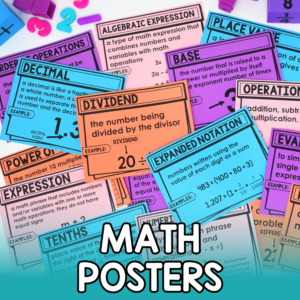
Math Posters
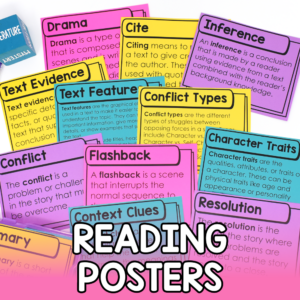
Reading Posters
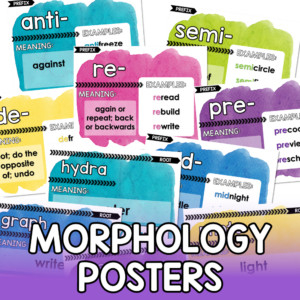
Morphology Posters
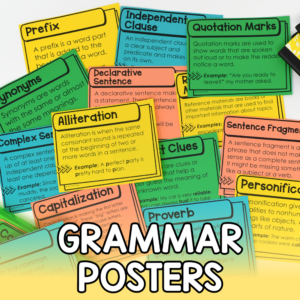
Grammar Posters
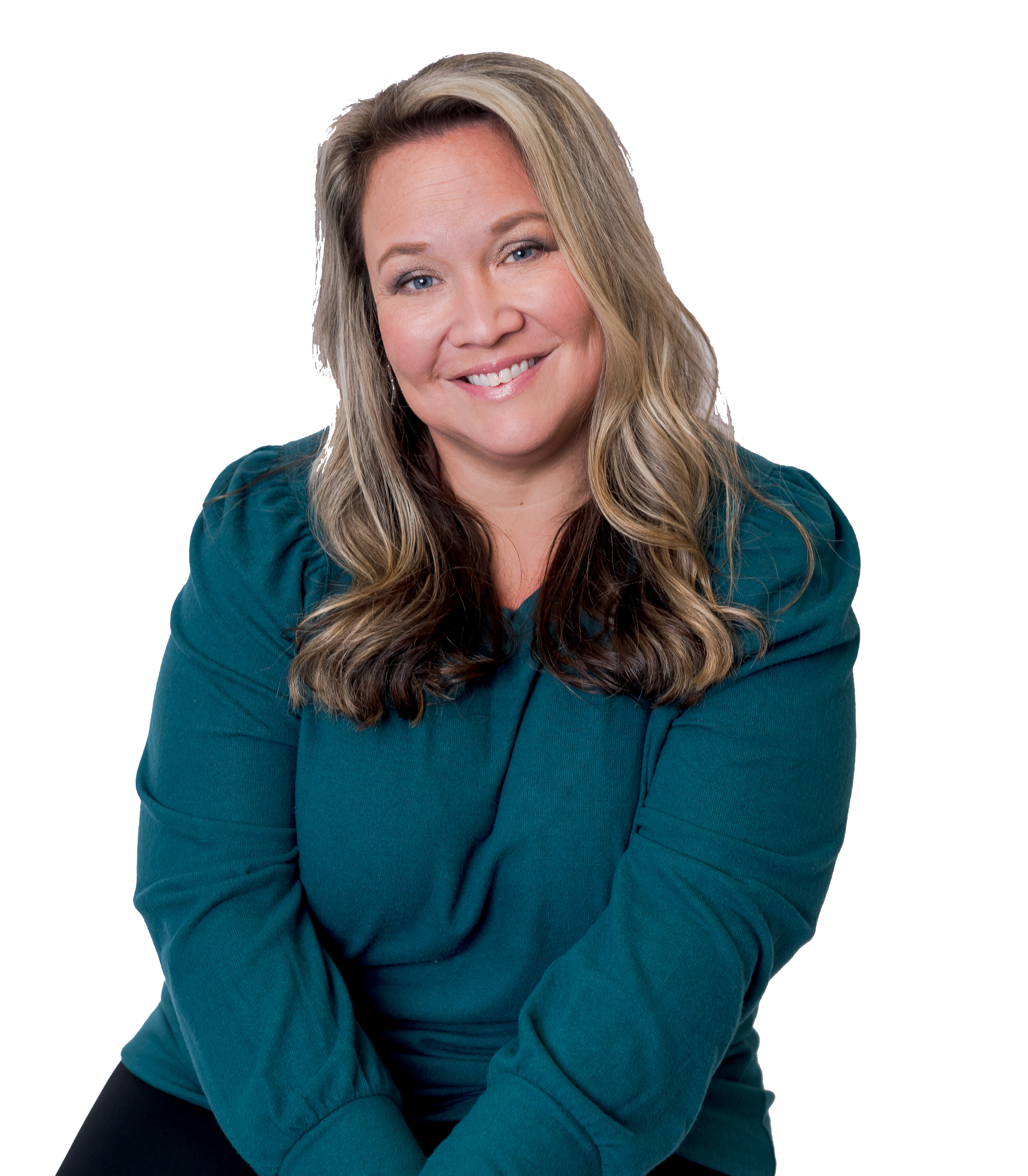
Welcome Friends!
I’m Jennifer Findley: a teacher, mother, and avid reader. I believe that with the right resources, mindset, and strategies, all students can achieve at high levels and learn to love learning. My goal is to provide resources and strategies to inspire you and help make this belief a reality for your students.
Writing in Math Class? Math Writing Prompts and Assignments
- Keren Perles
- Categories : Lesson plans for middle school math
- Tags : Teaching middle school grades 6 8
All Grades – Math Concepts
Students of all grades can benefit from writing out math concepts rather than simply solving problems. Here are some math prompts and activities that can help your students grasp concepts – and can show you where they need extra explanation as well. Some of the prompts are more general, and others relate to specific skills, but they can all be applied to various areas of math.
- What are the differences between [Math Concept 1] and [Math Concept 2]? What are the similarities between them?
- How could you use this math concept in your everyday life?
- Explain how you would solve the following problem: 2x – 7 = 15
- How can you tell if a number is divisible by 4? Why does this method work?
- What are two methods you can use to convert a fraction to a decimal? Which method do you prefer, and why?
- Why is it important to simplify fractions?
- Write an instruction manual to show someone how to do long division. Number each step.
- Write a quiz that would be a good test of whether a student understands what we’ve learned today.
- Describe the graph of y = x^2 in words so that someone in a different room could understand exactly what it looks like.
Lower Grades – Math Fiction
In the lower grades, introducing writing into the math curriculum serves a dual purpose – it helps students improve their writing skills, and it helps students who enjoy writing to carry that enjoyment over to math. The best way to incorporate writing and math class at the lower grades is by introducing math fiction.
Students write math fiction by taking a math skill they have learned and writing a fiction story that encompasses the skill. If you are teaching addition, for example, a student who enjoys fantasy stories might write the following:
“Two shiny fairies sat on a flower. One was pink, and the other was green. Three more fairies came to sit with them on the flower. Then there were five fairies!”
This may seem simplistic, but it can apply to more difficult skills as well, such as calculating money, fractions, simple algebra, and even probability and statistics. Essentially, students are creating their own word problems. Even though some students may struggle with word problems, creating a word problem can help them understand just how the problem works.
Upper Grades – Metacognition
Although students in the upper grades can benefit from writing math fiction under certain circumstances, they can also use writing to understand the way that they think. Metacognition, or thinking about thinking, is an important concept in education. When children are forced to think about their own thought processes, they clarify concepts for themselves. Reading their writing can also help you understand where your students are coming from, as well as how to help them reach their goals.
Here are several writing activities and prompts you can use in the math classroom to encourage metacognition:
- Write a math biography – or a history of your feelings about math. Include your first memories about math, any math classes that affected how you feel about math, and your current feelings about math. What were your best and worst experiences with math?
- Write about the subject you are learning in math class. What do you think about it? Do you find it easy or hard? Do you think it will be useful in the real world?
- What is the most interesting math skill you have ever learned? Which skill do you think you’ll use the most in life? Why?
- When you are struggling to do a math problem, how do you feel? What process do you use until you are finally successful?
- When you get a math problem wrong (and everyone does sometimes), what is your reaction? How would you like to react?
- Math is fun: agree or disagree? Discuss your answer.
- What goals do you have that relate to math? How do you hope to reach those goals?
- How do you study for a math test? Why do you think that your study methods work? How could you improve them?

- ELEMENTARY TEACHING , MATH
Elementary Math Journal Ideas that Get Kids Writing in Math in 2024
Integrating writing and math is critical in twenty-first century classrooms. Elementary students not only need to be able to accurately solve grade level problems, but also be able to explain their thinking and strategies both orally (e.g. number talks ) and in writing (e.g. math journal).
Mathematical writing is a great way to encourage students to make sense of concepts and skills, think critically, make connections, explain thinking, communicate ideas, practice literacy skills, self-assess, and reflect on learning.
Implementing a math journal routine in your elementary classroom is one way you can ensure your students are regularly writing in math and are continuing to grow as both mathematicians, writers, and critical thinkers.

This blog post will answer the following questions:
- Why is writing in math important?
- How do I get my students to write during math time?
- What are some tips for supporting writers during math?
- What are math journals?
- How do I write good math journal prompts?
- What are some examples of math journal prompts?
- What can I use a math journal for besides writing?
Why is Writing in Math Important?
Writing in math, specifically math journaling , is important because it gives children the opportunity to make sense of concepts and skills, think critically, make connections, explain thinking, communicate ideas, practice literacy skills, self-assess, and reflect on their learning.
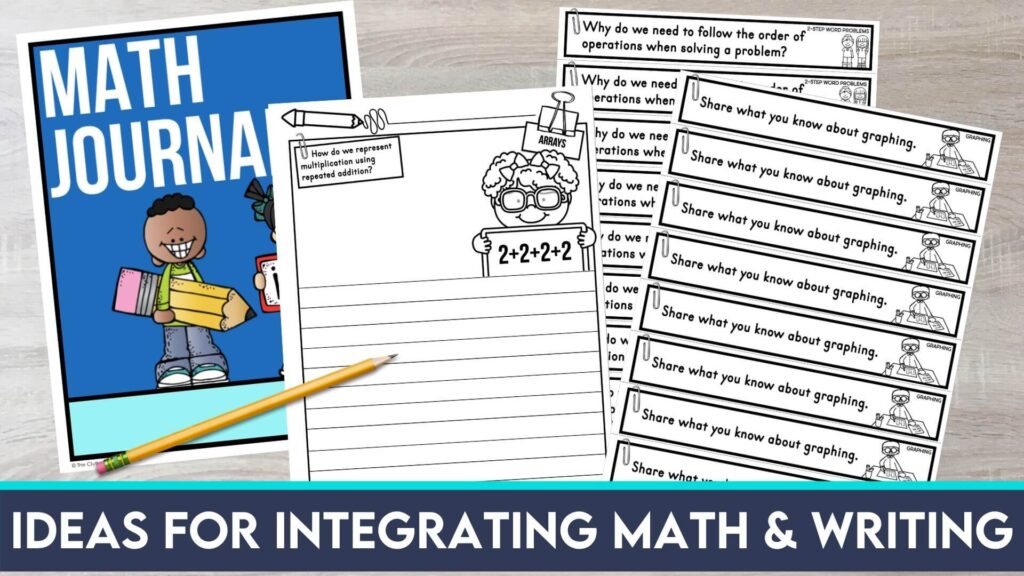
15 Ways to Get Students Writing During Math
Read below to learn about some of the many ways to improve math literacy and get students writing in math.
1. Daily Prompts
Give students a prompt at the beginning of class that asks them to make connections, justify rules, explain a procedure, etc. and have them write down their response.
2. I Think, I Notice, I Wonder
Pose a problem to students and ask them to fill in a graphic organizer with three categories: 1) I Think, 2) I Notice, 3) I Wonder.
3. Think-Write-Share
Pose a problem to the class. Have the students solve it and write how they solved it. When the time is up, invite students to share their strategy and explanation with a partner.
4. Read and Write
Read aloud a text or provide students with a text to read and have them respond in writing to a prompt based on the text.
5. Shared Writing
Work together as a whole group to communicate information about concepts, procedures, or strategies on chart paper.
6. Alphabet Book
Make an alphabet book as a class based on math vocabulary.


7. Take Notes
Invite students to take notes during the lesson by writing down procedures, definitions, etc.
8. Make Notes
Ask students to list the main points of a lesson and make connections between new concepts and previously-learned concepts.
9. Math Dictionary Entries
Students write vocabulary words and definitions in a notebook that they can refer back to.
10. Concept Maps
Ask students to create a graphic organizer to help them make sense of a math concept.
11. Technology
Utilize a class website or online tool to facilitate questions and discussions.
12. Act as the Teacher
Ask students to write their own story problem and share it with a classmate to solve. A second option is to have students create quizzes for each other.
13. Exit Ticket
Ask students to complete this formative assessment to determine their understanding of the lesson.
14. Assessment Reflection
When students get an assessment back after it is graded, ask them to analyze the problems they got incorrect and explain in writing what they did wrong and what they should have done instead.
15. Math Journal
Give students opportunities for journaling where they can reflect on and explore essential questions, big ideas, daily lessons, prompts, etc.
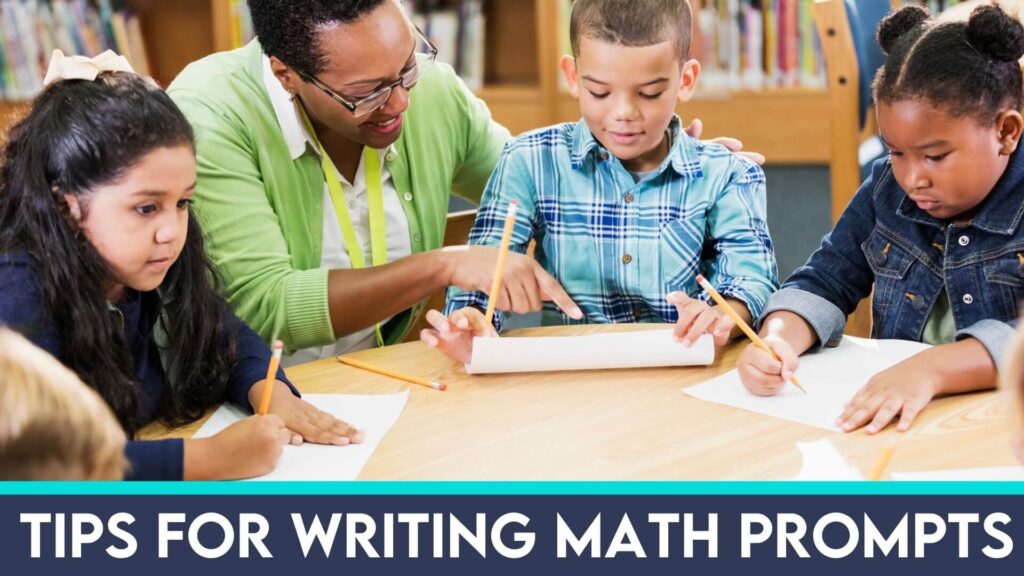
Tips for Supporting Writers During Math
- Write or post related vocabulary words in a spot where all students can see them. This blog post all about math vocabulary may be helpful!
- Explain who the students are writing to (teacher, a younger student, etc.).
- Encourage students to share their thinking and ideas with a partner before they begin to write.
- Invite struggling writers to formulate their idea with an adult in the classroom before they start their math journaling.
- Circulate around the room and support students as needed.
- Inspire students to use pictures, symbols, numbers, and words to add details to their writing through modeling those strategies yourself.
What is a Math Journal?
A math journal , also commonly referred to as a math notebook, is an ongoing and chronological record of what students are learning in math. It is a tool that helps students reinforce and reflect on their understanding of math concepts and skills.
Not only are math journals beneficial for students, but they are also beneficial for teachers too. Teachers can use math journals as a formal or informal assessment to monitor student progress and understanding.
Get these Math Journals!
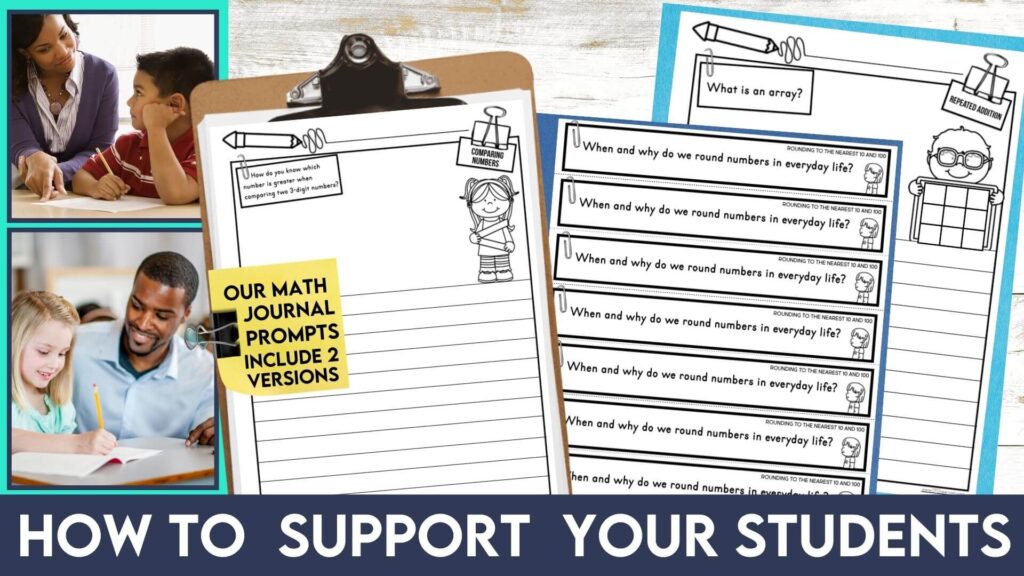
1st Grade Math Journals

2nd Grade Math Journals
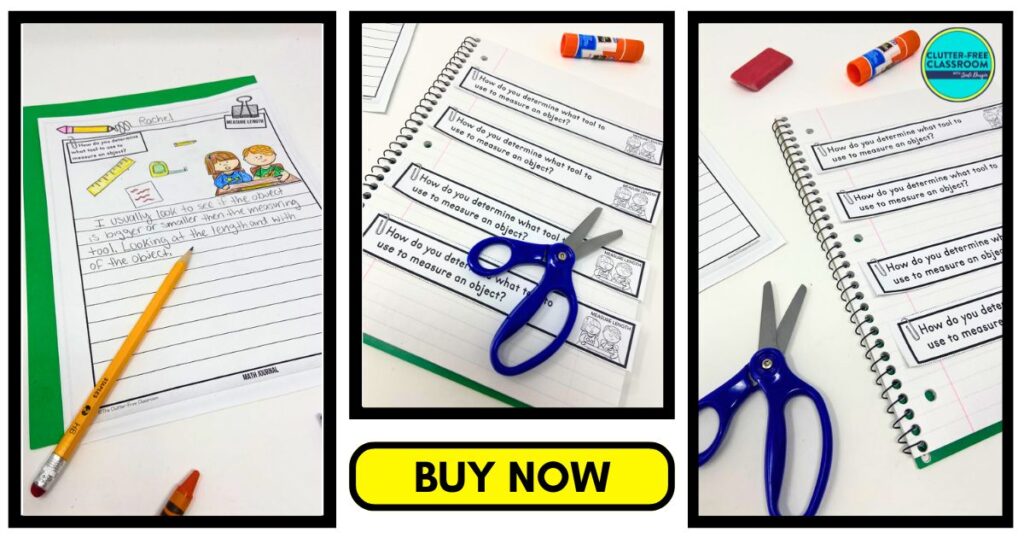
3rd Grade Math Journals

4th Grade Math Journals

5th Grade Math Journals

How to Write a Good Math Journal Prompt
A math journal prompt should be open-ended and an opportunity for students to…
- think deeply about a concept or skill
- problem solve
- learn from the question
- deepen their understanding of a concept or skill
- discover new ideas and connections
- explain their thinking
- reflect on their learning
- assess their own understanding and knowledge

3 Examples of Math Journal Prompts
Read the 3 math writing prompt examples below to get ideas for writing your own prompts for your students’ math notebooks:
Math Journal Prompt Example 1:
Math Writing Prompt : I have 5 coins in my pocket. Their sum is greater than $1. Give me 3 possible combinations.
Sample Answer : 5 quarters, 4 quarters and 1 dime, 4 quarters and 1 penny
Math Journal Prompt Example 2:
Math Writing Prompt : What are 5 things you know about the number 12?
Sample Answer : The number 12 is an even number; 12 has 1 ten and 2 ones; The number can be divided evenly into 2, 3, 4, and 6 groups; It has 2 digits; It is the sum or the doubles fact 6 + 6
Math Journal Prompt Example 3:
Math Writing Prompt : Prove 3 + 2 = 5.
Sample Answer : I know 3 + 2 = 5 because I know the sum of the doubles fact 2 + 2 is 4 and 1 more than 2 is 3 so 2 + 2 + 1 = 5. I just used the doubles plus one strategy!
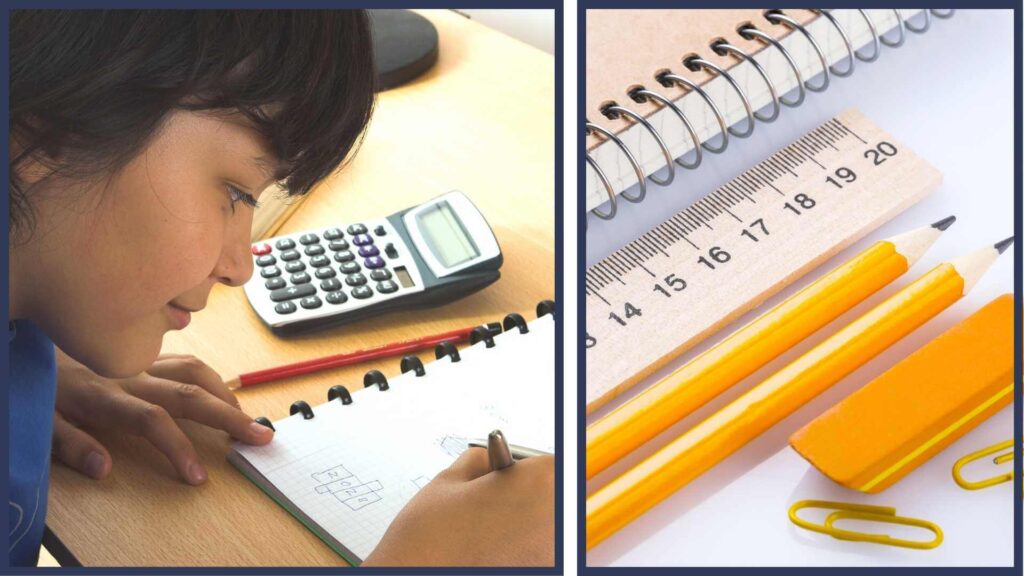
10 Things to Use a Math Journal For Besides Writing
Student math journals do not require students to solely write explanations in paragraph form in them. They can be filled with drawings, photographs, newspaper clippings and more. Here is a list of ideas that you can incorporate into your student math notebook center:
- articles about famous mathematicians
- math vocabulary words and definitions
- newspaper clippings related to math
- photographs of student work
- photographs of students solving problems
- sketches of symmetric objects
- student reflections
- tracings of math manipulatives
Math Resources for 1st-5th Grade Teachers
If you need printable and digital math resources for your classroom, then check out my time and money-saving math collections below!
Try These Math Writing Prompt Resources for Free!
We would love for you to try these math journal writing prompts with your students. They offer students opportunities to reflect on their learning through journaling and serve as a great consistent math center during Guided Math. You can download math journal worksheet examples specific to your grade level (along with lots of other math freebies) in our free printable math resources bundle using this link: free printable math activities for elementary teachers .
Check out my math journal resources !
- 1st Grade Math Writing Prompts
- 2nd Grade Math Writing Prompts
- 3rd Grade Math Writing Prompts
- 4th Grade Math Writing Prompts
- 5th Grade Math Writing Prompts

You might also like...
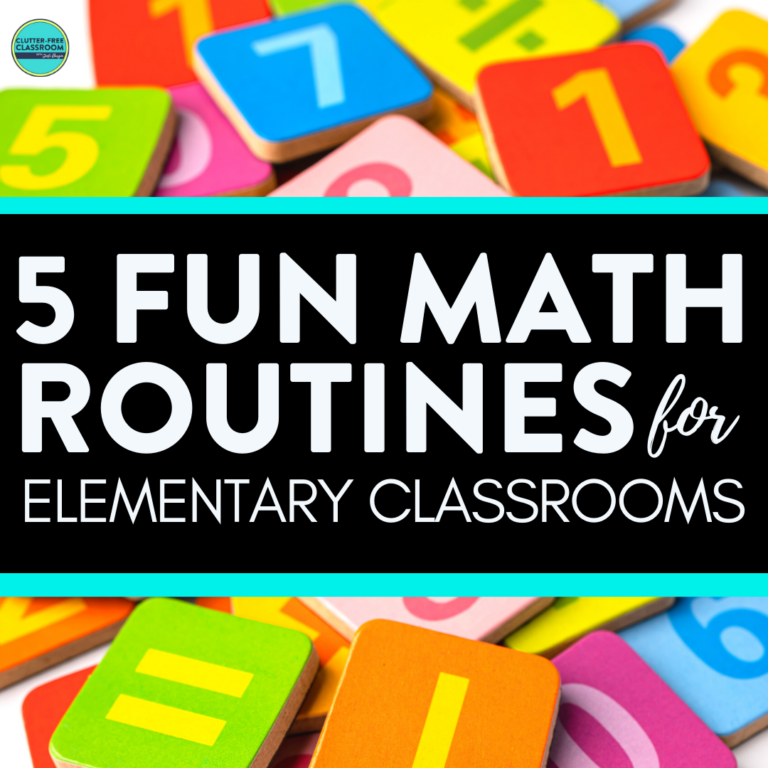
5 Fun Math Routine Ideas for Elementary Teachers

Using Number of the Day Activities for Teaching Number Sense in 2024
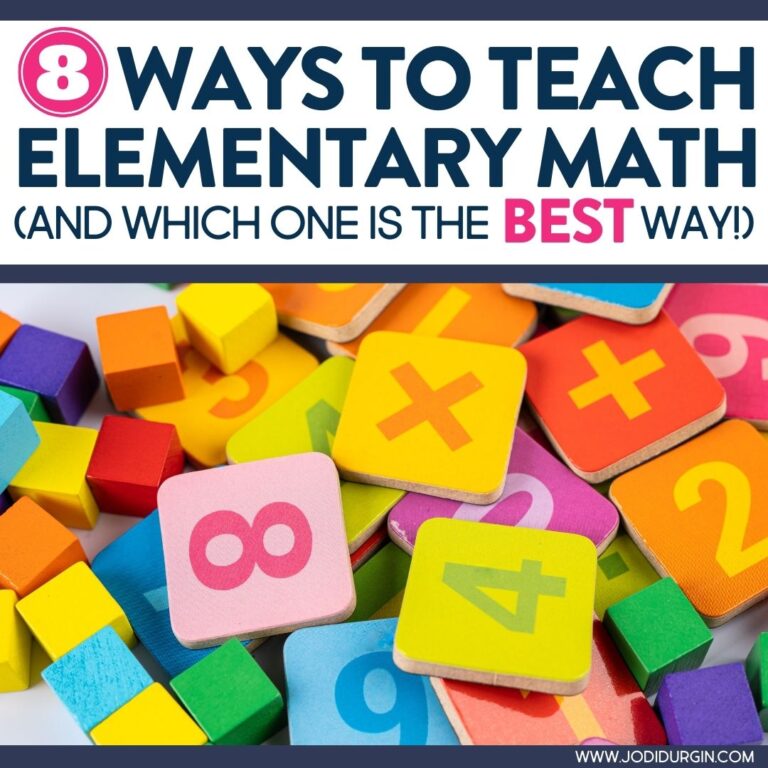
8 Types of Instructional Strategies for Teaching Math (Grades 1-5) in 2024
Join the newsletter.

- CLUTTER-FREE TEACHER CLUB
- FACEBOOK GROUPS
- EMAIL COMMUNITY
- OUR TEACHER STORE
- ALL-ACCESS MEMBERSHIPS
- OUR TPT SHOP
- JODI & COMPANY
- TERMS OF USE
- Privacy Policy
Get a collection of FREE MATH RESOURCES for your grade level!
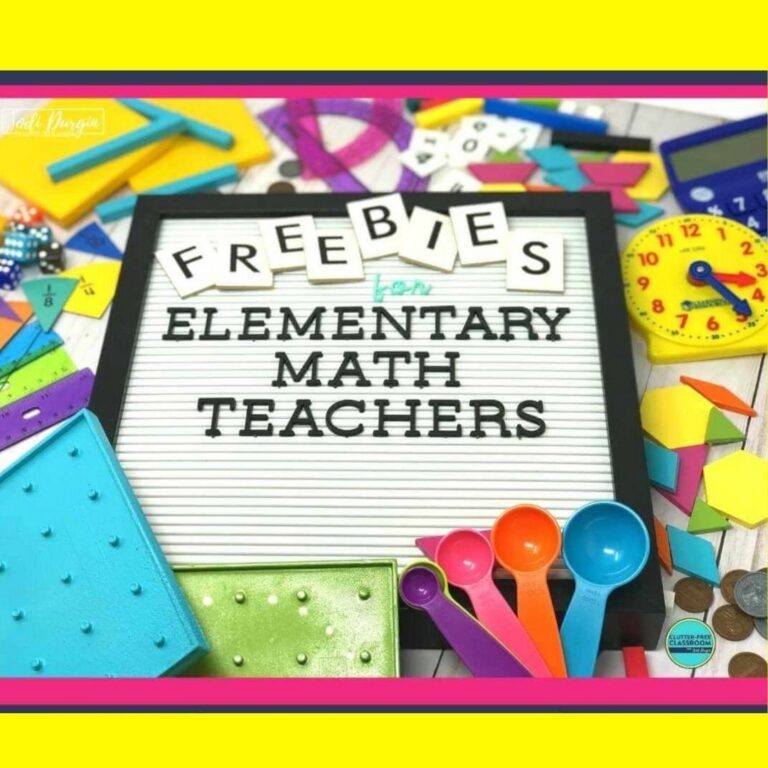

Math Wheels for Note-taking?

Exciting Math Writing Prompts for Your Middle School Classroom

Are you looking for a fun and engaging way to kick off the year in your math classroom? Well, the same old math lessons won’t cut it. Say goodbye to the yawns and snoozes that sometimes accompany the first week of rules and procedures, and say hello to a math classroom bursting with imagination and engagement. How, you ask? I have gathered 5 amazing math writing prompts that are perfect for the beginning of the school year. You’ll be able to create a buzz and excitement for the year to come while also getting to know your students and their math skills!
Why Writing Prompts in Math Are Mind-Blowingly Awesome
Why the hype about these writing prompts in math class? First off, it’s different and your students won’t expect it. Break down those math walls by starting the year with writing. These prompts are like bridges that connect math to the real world. They are like a sneak peek into why math class is so valuable.

Plus, they turn your math class into a creative think tank. When your students write about math, they’re not just solving problems; they’re explaining their thoughts. And dare I say you will learn more about your students as people through these prompts than you will through a traditional ice breaker.
With these math writing prompts, you’re not just teaching numbers. You’re igniting a passion for math that’ll (hopefully) last a lifetime. Let’s take a look at some of these prompts!
5 Math Writing Prompts for the First Week of School
1. math-powered welcome back to school bbq.
Calling all event planners, get ready to throw the ultimate Welcome Back to School BBQ that’ll be talked about all school year! Imagine stepping into the role of the party mastermind, but with a twist – this isn’t just any shindig. It’s a math-fueled fiesta. Your mission? Plan a spectacular Welcome Back to School BBQ for your class or even the whole school, and use math skills to make it a hit!

Research and budget for decorations, utensils, plates, napkins, and the star of the show – the delicious food, of course! Use your math skills to calculate how much of everything you need, factoring in the number of guests. How many plates, forks, and napkins are required? How much barbecue sauce to slather on those juicy burgers?
Then it’s time to get spatial. Think about the layout of your event. Are you setting up on the field, in the cafeteria, or maybe in the gym? You’ve got to figure out how many tables and chairs are needed and then put on your space-planning hat to ensure everything fits perfectly. Imagine creating a map where every table, chair, and food station finds its ideal spot, maximizing both comfort and party vibes.
Teacher Tip: Whether your kiddos actually do the event in real life or just plan it out, they are applying real-world math skills (budgeting to geometry) in an authentic and fun way!
2. Summer Snapshot Geometry Scavenger Hunt
Alright, memory-makers and shape-spotters, get ready for a math adventure that starts with your very own summer snapshots! Whether you’re sharing a vacation memory, a special event, or a scene close to your heart, you’re about to dive into a world of shapes and geometry that’s hiding in plain sight.
First things first, look through your camera roll and choose a picture of something you did this summer. Whether it’s sandy beaches, laughter-filled barbecues, or your favorite park hangout, let your snapshot be a glimpse into your summer story. Describe the picture – what’s happening, who’s there, and why it’s special to you. Let your words paint the scene for your readers.

Now, here’s where the math magic comes in. Take a closer look at your picture and embark on a geometry scavenger hunt! Search for shapes and patterns that might be hiding in your snapshot. Are there triangles formed by rooftops? Squares in the tiles underfoot? Circles in the sun or moon? Let your math detective skills shine as you identify and circle these geometric gems.
Lastly, connect the dots between your picture and the shapes you found by using vocabulary terms. Maybe that sunny beach scene has triangles in the sails of sailboats, parallelograms in beach towels, or even hexagons in the patterns of the sand. Explain how the geometry within your picture adds another layer of meaning to your summer memory knowing math is surrounding you!
Teacher Tip: Have a variety of photos available for students to choose from if they don’t have their own picture (or allow them to bring one from home). Using what you know about your student community, try to include pictures that might represent what your students did during the summer.
3. Math & Me
You are an amazing and unique person. It’s time to share about yourself with your new classmates. But there’s a twist. . . you must incorporate math in your description. In this activity, you’ll be using your math skills to create riddles that reveal fun facts about yourself, making it an awesome way to get to know your classmates through the world of numbers and puzzles.
Think about interesting facts from your life that you’d like to share – maybe it’s how many family members you have, your birthday month, or the number of trips you’ve taken. Now, turn these facts into math riddles. Challenge yourself to create questions that require a bit of math to solve, adding an extra layer of intrigue.

Once you’ve crafted your riddles, swap them with a partner or share them in a small group. Let your classmates put on their detective hats and use their math skills to solve your riddles. It’s a fun and engaging way to learn more about each other while waking up those math muscles!
As your classmates solve your riddles, reveal the answers and the interesting facts they unveil. It’s like a math-infused show-and-tell session where everyone gets to learn cool things about their peers in a playful and brain-stretching way.
Teacher Tip : Begin with your own math riddle and demonstrate how it works. This will help your students understand the activity and encourage them to create their own engaging riddles. A couple of examples are:
- I’m part of a family of 6. Add the number of letters of my favorite animal, ‘cat’, and the result is the number of siblings I have. How many do I have?
- If I multiply the number of days in a week by 2 and then subtract the number of months in a year, I get the answer to when my birthday is. What’s my birthday month?
4. Travel the World of Math: If You Could Go Anywhere
Alright, math adventurers, get ready to let your imagination take flight in a whirlwind journey of numbers and places! Imagine you’ve got a magic passport that lets you travel anywhere in the world, but with a twist—you’re going on a math-powered exploration. Whether you choose to jet off to the Eiffel Tower, the Great Wall of China, or even the depths of the Amazon rainforest, your mission is to discover the math hidden in every corner of your chosen destination.

Pick your dream travel spot and dive deep into its mathematical secrets. Maybe it’s measuring the angles of architectural wonders, calculating the distances between landmarks, or exploring the patterns in nature unique to that location.
You choose the destination and the math concept you want to use to explore it. For example, if you’re strolling through a bustling market, you could count the symmetrical patterns in the fruit stacks, figure out the ratios of different types of goods being sold, or determine which fruit stand has the best price per pound of fruit.
I can’t wait to see where the wonderful world of math takes you!
Teacher Tip: Have a list of recommended websites or some maps and travel brochures available for students to reference as they respond to this prompt. You can also connect with a social studies teacher for a joint effort activity during the first weeks of the year.
5. Math Time Capsule: Messages for Future Math Wizzes
It’s time to share your math knowledge with future generations. As a class, we will be creating a time capsule that won’t be opened for 50 years. We’ll pack it with letters loaded with math insights and puzzles. It’s passing on math magic to your fellow mathematicians of the future. How cool is that?
Imagine future mathematicians cracking open the time capsule and stumbling upon your nugget of math wisdom.

As a class, brainstorm some intriguing math concepts that you’ve learned. Think about ideas that future mathematicians will find fascinating. Perhaps it’s exploring patterns in nature, understanding multiplication with strategies you know, or unraveling the mystery of shapes and symmetry.
Each of you will craft a letter to future middle school math students. Share one of the math concepts you brainstormed and explain it in a way that’s easy to understand. Add in how you apply the math skill to your life to explain the “why” behind needing to learn it! Throw in a math puzzle or two that will work their minds.
Through your letters and puzzles, you’re building a bridge to future mathematicians, igniting their passion for math. You’ll be their motivator as they continue exploring the world of math in their year!
Teacher Tip: Show your students just how exciting it can be to open a time capsule and get a glimpse of the past. You might use a scene from a movie or book to build excitement about this activity.
Writing Prompts are Impactful in Math
These creative math writing prompts hold the power to transform the way students think about math and the real world. They provide a platform for students to explore the far-reaching domains where math extends its influence.

As you dive into these prompts during that first week of middle school, remember that you’re not just doing math – you’re embarking on a journey full of creativity and discovery. While you are helping your students get excited about math and what they will be learning, you also have so many opportunities to get to know your students and their math abilities.
Happy writing in math class!
Looking for writing prompts to help your students add details to their reasoning? Check out my blog post, Help Middle School Math Students Improve Problem-Solving Skills . Free recording sheets are included to help your students strengthen their math problem-solving and math communication skills!
Save for Later
Remember to pin this post to your favorite math Pinterest board to return to when you need creative writing prompts for your math classes!
read next...

Best Seating Arrangements for a Productive Math Class

How to Use Math Small Groups in Middle School

The Impact of Math Homework Assignments on Students’ Growth

Math Wheel Questions Answered to Help You Get Started

Welcome to Cognitive Cardio Math! I’m Ellie, a wife, mom, grandma, and dog ‘mom,’ and I’ve spent just about my whole life in school! With nearly 30 years in education, I’ve taught:
- All subject areas in 4 th and 5 th grades
- Math, ELA, and science in 6th grade (middle school)
I’ve been creating resources for teachers since 2012 and have worked in the elearning industry for about five years as well!
FIND IT FAST
Let's connect.

Select the image above to learn more!

Get FIVE days of free math lessons!

Terms of Use Privacy Policy
COPYRIGHT © 2022 COGNITIVE CARDIO MATH • ALL RIGHTS RESERVED. SITE DESIGN BY LAINE SUTHERLAND DESIGNS
Browse Course Material
Course info, instructors.
- Prof. Haynes Miller
- Dr. Nat Stapleton
- Saul Glasman
Departments
- Mathematics
As Taught In
Learning resource types, project laboratory in mathematics.
Next: Revision and Feedback »
In this section, Prof. Haynes Miller and Susan Ruff describe the criteria for good mathematical writing and the components of the writing workshop .
A central goal of the course is to teach students how to write effective, journal-style mathematics papers. Papers are a key way in which mathematicians share research findings and learn about others’ work. For each research project, each student group writes and revises a paper in the style of a professional mathematics journal paper. These research projects are perfect for helping students to learn to write as mathematicians because the students write about the new mathematics that they discover. They own it, they are committed to it, and they put a lot of effort into writing well.
Criteria for Good Writing
In the course, we help students learn to write papers that communicate clearly, follow the conventions of mathematics papers, and are mathematically engaging.
Communicating clearly is challenging for students because doing so requires writing precisely and correctly as well as anticipating readers’ needs. Although students have read textbooks and watched lectures that are worded precisely, they are often unaware of the care with which each word or piece of notation was chosen. So when students must choose the words and notation themselves, the task can be surprisingly challenging. Writing precisely is even more challenging when students write about insights they’re still developing. Even students who do a good job of writing precisely may have a different difficulty: providing sufficient groundwork for readers. When students are deeply focused on the details of their research, it can be hard for them to imagine what the reading experience may be like for someone new to that research. We can help students to communicate clearly by pointing out places within the draft at which readers may be confused by imprecise wording or by missing context.
For most students, the conventions of mathematics papers are unfamiliar because they have not read—much less written—mathematics journal papers before. The students’ first drafts often build upon their knowledge of more familiar genres: humanities papers and mathematics textbooks and lecture notes. So the text is often more verbose or explanatory than a typical paper in a mathematics journal. To help students learn the conventions of journal papers, including appropriate concision, we provide samples and individualized feedback.
Finally, a common student preconception is that mathematical writing is dry and formal, so we encourage students to write in a way that is mathematically engaging. In Spring 2013, for example, one student had to be persuaded that he did not have to use the passive voice. In reality, effective mathematics writing should be efficient and correct, but it should also provide motivation, communicate intuition, and stimulate interest.
To summarize, instruction and feedback in the course address many different aspects of successful writing:
- Precision and correctness: e.g., mathematical terminology and notation should be used correctly.
- Audience awareness: e.g., ideas should be introduced with appropriate preparation and motivation.
- Genre conventions: e.g., in most mathematics papers, the paper’s conclusion is stated in the introduction rather than in a final section titled “Conclusion.”
- Style: e.g., writing should stimulate interest.
- Other aspects of effective writing, as needed.
To help students learn to write effective mathematics papers, we provide various resources, a writing workshop, and individualized feedback on drafts.
Writing Resources
Various resources are provided to help students learn effective mathematical writing.
The following prize-winning journal article was annotated to point out various conventions and strategies of mathematical writing. (Courtesy of Mathematical Association of America. Courtesy of a Creative Commons BY-NC-SA license.)
An Annotated Journal Article (PDF)
This document introduces the structure of a paper and provides a miscellany of common mistakes to avoid.
Notes on Writing Mathematics (PDF)
LaTeX Resources
The following PDF, TeX, and Beamer samples guide students to present their work using LaTeX, a high-quality typesetting system designed for the production of technical and scientific documentation. The content in the PDF and TeX documents highlights the structure of a generic student paper.
Sample PDF Document created by pdfLaTeX (PDF)
Sample TeX Document (TEX)
Beamer template (TEX)
The following resources are provided to help students learn and use LaTeX.
LaTeX-Project. “ Obtaining LaTeX .” August 28, 2009.
Downes, Michael. “Short Math Guide for LaTeX.” (PDF) American Mathematical Society . Version 1.09. March 22, 2002.
Oetiker, Tobias, Hubert Partl, et al. “The Not So Short Introduction to LaTeX 2ε.” (PDF) Version 5.01. April 06, 2011.
Reckdahl, Keith. “Using Imported Graphics in LaTeX and pdfLaTeX.” (PDF) Version 3.0.1. January 12, 2006.
Writing Workshop
Each semester there is a writing workshop, led by the lead instructor, which features examples to stimulate discussion about how to write well. In Spring 2013, Haynes ran this workshop during the third class session and used the following slide deck, which was developed by Prof. Paul Seidel and modified with the help of Prof. Tom Mrowka and Prof. Richard Stanley.
The 18.821 Project Report (PDF)
This workshop was held before students had begun to think about the writing component of the course, and it seemed as if the students had to be reminded of the lessons of the workshop when they actually wrote their papers. In future semesters, we plan to offer the writing workshop closer to the time that students are drafting their first paper. We may also focus the examples used in the workshop on the few most important points rather than a broad coverage.
- Download video
This video features the writing workshop from Spring 2013 and includes instruction from Haynes as well as excerpts of the class discussion.

You are leaving MIT OpenCourseWare
Center For Education Efficacy, Excellence, and Equity logo
‘registering’ math academic language: providing supports for english learners.
Posted May 30, 2024 by snp146
By Anita Sundrani and Asia Ellis
In recent years, there has been a significant shift in the way students are taught mathematics. Math is no longer just about basic computation and procedures. Students are tasked with solving real-world problems that require a high level of proficiency in academic language . Strong academic language skills allow students to build a deep conceptual understanding of the mathematics content and practices necessary for success in today’s classrooms.
In light of these shifts, we share an overview of academic language, with a focus on three related facets that connect to E4’s research priorities: 1) mathematics academic language, 2) challenges faced by English Learners in developing their academic language toolkit, and 3) strategies mathematics teachers can use to support English Learners’ academic language development.
What is academic language?
At its core, academic language is the form of communication used in schools and in classrooms, which differs from the language that is used at home and in other contexts.
Researchers have proposed many different frameworks that explain how students develop academic language. Some focus more on the individual student’s experiences (i.e., cognitive ), while others focus more on the surrounding environment (i.e., raciolinguistic , sociocultural , sociolinguistic ).
Our exploration of academic language takes a sociolinguistic and sociocultural approach. This perspective highlights the unique nature of social interactions in the classroom, and the ways they differ from everyday exchanges. In other words, they have their own register .
What is a Register?
In linguistics, a register is the way people use different types of language in different contexts – for example, a scientist needs to make specific language choices when engaging in a professional setting that may differ from their everyday language (See Moschkovich, 2015 ; Sarris & Chavez, 2020 ; Wilkinson, 2019 ). The term applies to both speaking and writing.
How does academic language fit in math?
Standards in mathematics, such as the Common Core State Standards require students to have a deep understanding of the language of mathematics to solve problems. Students should be able to demonstrate their understanding of a problem by listening to and reading descriptions of the problem and then discussing related concepts with peers and teachers. Underlying each of these expectations are the four equally important areas of language – vocabulary, syntax, semantics, and discourse.
- Academic Vocabulary
- Syntax and Semantics
Mathematics Academic Vocabulary
Mathematics academic vocabulary is the component of academic language that gets the most airtime and experts agree: the unique vocabulary associated with mathematics (e.g., diameter, vertex, ratio) supports overall language development. When targeting mathematics academic vocabulary in the classroom, educators need to define terms explicitly, giving examples in the relevant context to illustrate meaning.
The National Council of Teachers of Mathematics (NCTM) cautions against teaching mathematics (and vocabulary) without a context, instead encouraging the introduction of real-world connections once students have mastered the mathematics content procedurally. A more decontextualized approach makes it more difficult for students to engage in mathematical discourse when the time arrives. Instead, vocabulary should be integrated into everyday instruction through high-cognitive demand activities that balance both conceptual and procedural understandings of mathematics. Teachers should also engage students in opportunities to discuss what they’re learning orally and in writing (one such example is provided below).
Mathematics Syntax and Semantics
Semantics references the overall meaning of a statement in context. For example , “in a mathematical word problem, four plus seven times a certain number is 20; what is the number , students must infer that a certain number and the number are actually the same number.” This applied use of the mathematics register takes time for students to master, so it is important that students have multiple opportunities to make sense of word problems and symbols.
Syntax focuses on the structure of statements. For instance , students need to understand the relationship between words, such as “greater than” or “the same as” in order to work with equations and inequalities. Taken together, students begin to learn how to speak and write as mathematicians and understand what is being asked of them in the mathematics classroom. Despite the language-rich underpinnings of the mathematics register, teachers may be hesitant to include literacy instructional practices in their teaching, believing that language learning is outside of their expertise and focus as math teachers.
Mathematics Discourse
Though most scholars agree that discourse is an integral component of language acquisition, they disagree on how it should be introduced. Some believe that students must first master vocabulary and mathematics procedures prior to engaging in discussion, while others believe that all aspects of mathematics academic language can be developed simultaneously through purposeful mathematics discourse. Expert Judit Moschkovich explains that mathematics discourse “involves not only written text, but also multiple modes, representations (gestures, objects, drawings, tables, graphs, symbols, etc.), and registers.” This means that math instruction should focus on conceptual understanding of math content and engage students in explaining, reasoning, and justifying their mathematical ideas with their peers, teachers, and in writing .
How does mathematics academic language affect English Learners’ success in math?
Due to the instructional shift toward conceptual understanding and real-world applications, English Learners (ELs) face unique challenges while learning mathematics. In particular, learning in a nonprimary language requires a heavier mental load to move from one register to another, a process more commonly known as “code-switching.” Code-switching (also known as translanguaging) can lead to more oral and written errors because the learner has to constantly switch between their primary language and nonprimary language where the syntax may be different .
There is also the added challenge of technical” and “subtechnical” vocabulary words . “Technical” vocabulary words that have a mathematical definition (e.g., circle) and “subtechnical” words that may have both a mathematical definition and colloquial one (e.g., “yard” is a unit of measurement and can also refer to an area outside a home).
This culmination of challenges, along with the misconception that mathematics should be separate from language instruction, may lead teachers to underestimate the true mathematical abilities of ELs compared with their English monolingual peers. Because of this, teachers may unnecessarily assign ELs more content below grade level than their English-only classmates, leading to widening gaps in mathematics performance (see here and here ).
Mathematics Instructional Strategies for English Learners It is more appropriate to provide ELs with high-quality tools that are responsive to their mathematical strengths and primary language to better enable them to access on-grade-level material. These strategies should emphasize:
- a balance between conceptual and procedural understanding,
- high cognitive demand,
- positive beliefs about mathematics, and
- the eight Common Core mathematical practices.
Potential strategies include:
Introducing els to mathematics vocabulary in context with brief mathematics language lessons..
For example, Ellevation, an organization designed to both serve ELs and teachers of ELs, offers math primers to support Els in math. Math primers are quick five-minute lessons that introduce students to a mathematical term and present a real-world application of the term, aided by a mathematics representation as a visual anchor. Their goal is to use a contextualized approach to mathematics vocabulary to help ELs engage in rich discourse with their peers, and in turn, access grade-level material at any level of proficiency. A recent investigation found that implementing this strategy in isolation sporadically during the academic year does not have an impact on ELs’ mathematics knowledge. This finding supports Moschkovich’s assertion that mathematics academic language development should be a holistic endeavor that should combine language development and mathematics proficiency through mathematical discourse.
Focusing on students’ mathematical reasoning in their argument, as opposed to precise language usage.
This approach puts the emphasis on students’ understanding of concepts, instead of the register, which then allows students to gradually become accustomed to the register through repeated oral and written practice. Also, listening for students’ mathematical ideas frames them as knowledgeable about mathematics, and avoids a deficit mindset about ELs .
Acknowledging the complexity of language and the different ways it takes place in the classroom.
Students are expected to speak, read, and write in the mathematics register, recognize multiple representations (e.g., tables, graphs, pictures, symbols), understand different forms of text (e.g., textbook explanations of concepts, word problems), and to communicate with different audiences. Therefore, teachers should provide ELs, as well as their peers, plenty of opportunities to engage in the complexity of language through different modalities and sequence them in ways that support comprehension (see related work on this topic by Moschkovich (2012) , Peng and colleagues (2020) , and Sarris and Chávez (2020) ).
Academic language is complicated and nuanced, as each subject area requires instruction to be responsive to its specific register. Although there are commonalities across subjects–including a focus on vocabulary, syntax, semantics, and discourse–the strategies to develop these language components are distinct. Within mathematics education, language instruction is often overlooked as math is viewed as the subject of numbers. This forces English learners to simultaneously learn English and the mathematics register. However, there are numerous strategies that frame ELs as doers of mathematics while they learn both. When teachers recognize and build upon ELs mathematical strengths and knowledge, these students are better situated to grow and thrive as learners across the board.
Categories: Author: Anita Sundrani , Author: Asia Ellis , Research Brief
Feedback and assessment for writing
Commenting strategies, choosing grading criteria, grading for small writing assignments, grading for large projects, encouraging students to do more than superficial revision, literature on assessing writing, assessing “writing-to-learn” assignments, using writing to assess understanding of mathematics, general resources and research (not specific to mathematics).
Most of this page focuses on “learning to write”; i.e., on assessing how well students communicate mathematics. Near the bottom of the page are sections on “writing to learn” and “writing to assess”: some writing assignments are designed primarily to help students to learn mathematics, while others are designed primarily to help teachers assess student understanding of mathematics. These call for different feedback and assessment strategies than “learning to write.”
As you give students feedback on their writing, you might consider commenting on mathematical correctness, clarity, flow and organization, and other general principles of communicating mathematics . A balance must be found among verbose commenting, a reasonable time investment, and what’s most helpful for students. Some suggestions:
- Consider your purpose for commenting and craft your comments to achieve that purpose.
- To gain a sense of the effect of comments on students, see the video “ Beyond the Red Ink: Teachers’ Comments through Students’ Eyes .” Although these students are first-year humanities students, experience suggests that upper-level mathematics students are not far different.
- Consider meeting with each student to provide feedback. Although scheduling meetings can be a hassle, feedback given in person is often more efficient and richer than feedback given in writing, and you’ll get to understand the students better as writers by hearing their responses to your comments.
- Point out what the student does well. Positive feedback is remarkably effective.
- Remind yourself to consider the text at all scales: it’s easy to overlook large issues when you’re focused on details.
- Consider how much the student can learn in the available time: there’s no need to list all types of problems in a paper. Decide what the student most needs to learn at this point and consider giving only those comments. [When planning an assignment, consider scheduling multiple revisions so large-scale issues may be addressed during the first revision and smaller-scale issues may be addressed during later revisions.]
- If you feel you must provide many comments, you can help students recognize the relative importance of the various comments by drawing attention to the most important ones in a summary note.
- Less important issues can be de-emphasized through the use of coded comments (see this example of comment codes from MIT’s communication-intensive mathematics subjects and this example of comment codes from an engineering class at MIT ).
- Do not mark each instance of a recurring problem: instead tell the student how to identify the problem for him/herself.
- If you’re distracted by an error until you mark it, very briefly mark errors on a scratch paper or in a temporary document, providing only enough information for yourself. Then when you’ve finished reading, decide which comments to give the student.
- If the writing will not be revised, then limit yourself to general comments that apply to future writing.
- Suggest that the student keep an editing checklist of mistakes he or she often makes.
- The student is the author, so when you draw attention to a problem, avoid dictating a solution unless necessary.
- To avoid comments being taken personally, refer to the text, not to the student: “This paragraph could be more concise.” not “You don’t write concisely enough.” To write helpful comments, consider these dimensions of commenting .
- Reading papers is time consuming and occasionally frustrating. Take care to remain professional.
For further explanation of the above suggestions, see these two pages about Commenting.
In addition to or instead of giving individualized feedback, you may choose to give feedback to the class as a whole. Example: Guidance for revising an algorithm assignment .
Identifying and prioritizing grading criteria before grading is important to prevent unintentional, subconscious bias, even in graders who consider themselves objective, as found by this study of hiring decisions based on criteria prioritized before/after learning about an applicant: Uhlmann and Cohen, “ Constructed Criteria: Redefining Merit to Justify Discrimination ,” Psychological Science, Vol 16, No 6, pp. 474-480, 2005.
Guidance for how to create a rubric is provided on the MAA Mathematical Communication page “ How can I objectively grade something as subjective as communication ?”
For a detailed explanation of this strategy, see this grading handbook , which includes sample lists of characteristics of good mathematical writing and sample rubrics, as well as guidance for grading drafts, etc.
One strategy is to assign two grades to each small writing assignment: one for mathematical content and one for quality of exposition. To speed up grading, you may want to assign an overall exposition grade rather than one for each problem on the assignment (if there are multiple). Make sure your students are aware that effective communication is being evaluated and will contribute to their grade. If possible, give them a rubric or a sample of what you are looking for.
Example: Janet Preston’s rubric for week-long projects like mathforum.org ‘s problems of the week .
Example: 18.310C rubric for grading heapsort algorithm
If you give students a rubric before the assignment is due, they are likely to write to the rubric. If you are new to teaching mathematical writing, consider not providing a rubric for the first writing assignment, so you have the opportunity to see how students write on their own. You may then design future rubrics to emphasize whichever writing characteristics you most want students to emphasize.
The grading of the final project should reflect all of its aspects: proposal, any intermediate drafts, peer-review, and final product. It may be helpful to the students to see the grading rubric you will use; many of them will not have written a long piece of mathematics before.
Here is an example of a rubric for grading a draft. Two grades are assigned: the grade that counts is based on effort/completeness, but students are also given a temporary “advisory grade” based on the rubric for the final paper. This strategy rewards effort while allowing room for improvement and giving information about how much improvement is needed.
For the final paper, you may want to grade the following:
- Correctness of mathematics
- Clarity of exposition
- Flow and organization of paper
- Other general principles of communicating math that you consider to be most important
- Extent to which feedback was incorporated. (Some students may be disinclined to incorporate feedback unless doing so is built into the grading.)
A sample rubric for the final paper is included with the rubric for the draft (above). A rubric can be designed not only as an assessment tool but also as a teaching tool, as explained and illustrated in this blog post . Another option is to use a more detailed grading grid ; however, writing mathematics well is complicated, and it may not be possible to create a precise grid that sufficiently captures the diversity of strengths and weaknesses of students’ writing.
Sometimes students revise only superficially when major revisions are needed. To help students understand the extent of revision needed, and to encourage them to make significant revisions when those are required, consider the following strategies:
- If major revision is needed, give only high-level comments. Giving detailed comments will cause students to focus on details and may cause them to lose sight of the big picture, thus preventing major revision.
- Explicitly tell students which sections of the paper ought to be “rewritten” rather than “revised” and what’s meant by those terms.
- Avoid scheduling revision at the end of the term when students are pressed for time.
- Meet with students individually to give them a chance to ask questions about feedback. The one-on-one attention also makes clear to students that you consider the quality of writing to be important.
- If you have a writing workshop in which you show students drafts of your own writing, choose drafts that exhibit major revision. By modeling major revisions yourself, you’ll help students to realize that they may also need to make major revisions.
- Have students assess the quality of their own writing and submit a revision plan.
- Require students to indicate which changes they made and explain why changes were not made.
- Include in the grade the extent to which instructor and peer comments were addressed.
- Patrick Bahls’ 2012 book Student Writing in the Quantitative Disciplines: A Guide for College Faculty contains a chapter on Assessing and Responding to Student Writing.
- Crannell, A., “Assessing Expository Mathematics: Grading Journals, Essays, and Other Vagaries,” Assessment Practices in Undergraduate Mathematics , MAA Notes #49 .
- Emenaker, C.E., “Assessing Modeling Projects in Calculus and Precalculus: Two Approaches,” Assessment Practices in Undergraduate Mathematics , MAA Notes #49 .
- Crannell, A., “How to grade 300 math essays and survive to tell the tale,” PRIMUS 4 (3), 1994.
- Houston, S.K., et al. , Developing Rating Scales for Undergraduate Mathematics Projects , University of Ulster, 1994.
- Dennis, K. “Assessing Written and Oral Communication of Senior Projects,” Supporting Assessment in Undergraduate Mathematics , The Mathematical Association of America, 2006, pp. 177-181 . Contains rubrics for presenting and writing, with recommendations.
If the primary purpose of a writing assignment is to help students to better learn the mathematics, then providing feedback on the process is likely to be more important than grading writing quality.
- C. L. Patterson and P. V. Prasad, “ Beyond Grades: Feedback to Stimulate Rethinking and Intellectual Growth ” On Teaching and Learning Mathematics AMS Blogs, American Mathematical Society, August 6, 2018. Patterson and Prasad use feedback and revision instead of grades to increase student learning from writing assignments.
- Morgan, C., Writing Mathematically: The Discourse of Investigation , Falmer Press, 1998. From the Google Books review : “…[using] written language to serve as ‘evidence’ of their mathematical activity and achievement,… raises two important questions. Firstly, does this writing accurately present children’s mathematical activity and ability? Secondly, do math teachers have sufficient linguistic awareness to support their students in developing skills and knowledge necessary for writing effectively in their subject area?”
- See also the general resources for assessing understanding of mathematics, listed on the Assessment page.
- focusing your commenting energies
- using a grading sheet (including sample grading sheets)
- evaluating writing to learn assignments
- “ Beyond the Red Ink: Teachers’ Comments through Students’ Eyes ” Conversations with Bunker Hill Community College Students, Bedford/St. Martin’s
- John C. Bean’s Engaging Ideas: The Professor’s Guide to Integrating Writing, Critical Thinking, and Active Learning in the Classroom includes a clear and helpful chapter on Reading, Commenting On, and Grading Student Writing.
- Nancy Sommers’ Responding to Student Writing Bedford, St. Martins, 2013. ( publisher’s page )
- Bracey, E., “ The Will to Revise: Commenting, Revision, and Motivation in College Students “, Xchanges , Issue 9.1, 2013. Bracey’s research supports some prior results by indicating that the revisions of students who use a writing center focus on those aspects of writing that are emphasized most in their professor’s comments: e.g., if the professor comments only on grammatical issues, the students focus only on grammatical issues and resist writing center assistance on clarity, coherence, etc. This 2013 article begins with a helpful review of research on the factors that motivate student revision.
- Taylor, S. S., “ ‘I Really Don’t Know What He Meant By That’: How Well Do Engineering Students Understand Teachers’ Comments On Their Writing? ” Technical Communication Quarterly , Vol. 20, No. 2, pp. 139-166, 2011. Teachers and engineering students from one institution were interviewed about the teachers’ comments on the students’ papers. Students recognized the focus of about three quarters of teachers’ comments but understood the reasons for only half of the comments. The results are broken down by type of comment and discipline of teacher. Recommendations are suggested, including that teachers provide more explicit explanations for comments. This 2011 article begins with a helpful review of research on response and on student reception of response.
- Summers, N., C. Rutz, and H. Tinberg. “ Re-Visions: Rethinking Nancy Sommers’s ‘Responding to Student Writing .’ 1982.” CCC Vol 58, No 2 (2006) pp. 246-266. This collection of three essays summarizes some past and current (as of 2006) research and thinking about responding to student writing. In the first essay, “Across the Drafts,” Nancy Sommers summerizes some of the findings from the Harvard Study of Undergraduate Writing, which followed the writing of and feedback received by 400 students over their four years at Harvard.
- Anson, Chris M. “Response Styles and Ways of Knowing.” Writing and Response Theory, Practice, and Research. Ed. Chris Anson. Urbana: National Council of Teachers,1989. 332-366.
- Grading Writing: the Art and Science–and why computers can’t do it , by Doug Hesse.
- Uhlmann and Cohen, “ Constructed Criteria: Redefining Merit to Justify Discrimination ,” Psychological Science, Vol 16, No 6, pp. 474-480, 2005.
- See also the resources on this site’s general page about assessment .
Please suggest key research to add to this list.
What is Math Comm
Latest updates.
- Teamwork workshop
- Giving a lecture or workshop on writing
- Written genres
- Reading Assignment-Info Thy Writing Workshop
- Number Theory–Scott Carnahan
- Types of proof & proof-writing strategies
Recent Blog Posts
- Best Writing on Mathematics 2015
- 2014 MAA Writing Award Winners: American Mathematical Monthly
- 2014 MAA Writing Award Winners: Mathematics Magazine
- 2014 MAA Writing Award Winners: College Mathematics Journal
- 2014 MAA Writing Award Winner: Math Horizons
- Math by the Minute on Capitol Hill
- MAA Writing Awards
- Course Communities
- MAA Reviews
- Classroom Capsules & Notes
Accessibility

Math in Office
User, developer, and accessibility info on math editing/display in Microsoft Office and Windows. New features and specifications of the RichEdit editor. Getting OfficeMath onto web apps

It’s been so fine!
Math Dictation
Itextdocument2 setproperty and getproperty, displaying math in wordpress, math speech strings and localization, using richedit for text processing, default math properties, richedit hyperlinks, setting and getting text in various formats, computers i have known.


IMAGES
VIDEO
COMMENTS
Find a variety of math writing prompts that can be used for different writing purposes and grades. These prompts encourage students to apply math skills, think critically, and reflect on their learning.
These prompts are fairly basic, which leaves room for you to alter them to match your class's grade level and skill. Here are a few ways you can use these prompts in your classroom: Keep these prompts handy for students to use if they finish their classwork early. Reserve part of your math period for journal writing, to help students think ...
The following tips will help you make the most of these middle school math writing prompts: 1. Pair Work: In pair work, students collaborate to complete the writing prompt. This might involve brainstorming ideas together, discussing how to approach the prompt, writing a joint response, or peer-reviewing each other's work. By collaborating ...
How Math Writing Prompts Help Students. 1. Enhancing Problem-Solving Skills: Math journal prompts are more than just a way to practice math; they're a gateway to developing advanced problem-solving skills. When students write about math problems, they learn to approach these problems from different angles.
Learn how to help students communicate their math ideas through writing, such as pictures, lists, word problems, summaries, and reflections. Find free resources and tips for integrating writing into math lessons and assessments.
Find 20 fun and educational math writing prompts to help students improve their math skills and confidence through words. Learn how journal writing can benefit math learning and explore different math topics and concepts.
Learn how writing can enhance mathematical understanding and communication in the classroom. Explore four strategies to elicit impactful explanations, model mathematical thinking, and provide feedback on writing.
Learn how to use math journaling prompts to improve your math skills and understanding. Find 101 prompts for different math concepts, levels, and interests, and get tips on how to start and benefit from math journaling.
Learn how to design and assign writing tasks that help students communicate as mathematicians. Find examples of short assignments, term papers, and resources for different levels and topics of mathematics.
Learn how to teach, assign, and assess mathematical writing in various contexts and genres. Find resources, examples, and tips for improving your students' writing skills and learning outcomes.
7. Use math journals and math prompts. This is probably one of the easiest ways that you can get students writing more in math. You can use journal or prompt writing as a warm up for the math lesson or even as a separate station. There are two main types of math journal prompts I use: Grade-Level/Skill Specific Prompts and General Math Prompts.
Writing Across the Disciplines: Writing Prompts for Math, Science, and Social Studies. These prompts do not have to be used exactly as stated below. Reword them to fit your curriculum, learning goals, and grade level. Math • Explain how you solved this problem. Describe a second strategy you could use to confirm your answer is correct.
Integrating Writing Prompts into Math Lessons. When it comes to teaching math, incorporating writing prompts can be a powerful tool to engage students and deepen their understanding of mathematical concepts. By combining the logical thinking skills of math with the creativity and critical thinking skills of writing, students can gain a more holistic ...
Learn how to use writing in math class to help students grasp concepts, improve writing skills, and think about their own thinking. Find prompts and activities for all grades and math topics, from lower to upper levels.
A Guide to Writing Mathematics Dr. Kevin P. Lee Introduction This is a math class! Why are we writing? There is a good chance that you have never written a paper in a math class before. So you might be wondering why writing is required in your math class now. The Greek word mathemas, from which we derive the word mathematics, embodies the
Prompts 1-12 come from Marvelous Math Writing Prompts, by Andrew Kaplan, Scholastic, 2001. Prompts 13-18 come from Standards-Based Math Graphic Organizers, Rubrics, and Writing Prompts for Middle Grade Students , by Imogene Forte & Sandra Schurr, Incentive Publications, 2001.
15 Ways to Get Students Writing During Math. Read below to learn about some of the many ways to improve math literacy and get students writing in math. 1. Daily Prompts. Give students a prompt at the beginning of class that asks them to make connections, justify rules, explain a procedure, etc. and have them write down their response. 2.
December 12, 2022. Writing about math helps kids to organize their thinking, use key vocabulary, and communicate mathematically—which leads to deep and meaningful understanding. Over the past few years, math teachers are incorporating more writing activities into their lesson plans—a trend that is being driven by the use of highly engaging ...
Writing Prompts are Impactful in Math. These creative math writing prompts hold the power to transform the way students think about math and the real world. They provide a platform for students to explore the far-reaching domains where math extends its influence. As you dive into these prompts during that first week of middle school, remember ...
Writing in mathematics should be careful of tense. When describing facts, use present tense (facts are true). When describing experiments or methods, use past tense (experiments were conducted). Hamilton College Writing Center's "Writing for Science" resources provide helpful models.
Criteria for Good Writing. In the course, we help students learn to write papers that communicate clearly, follow the conventions of mathematics papers, and are mathematically engaging. Communicating clearly is challenging for students because doing so requires writing precisely and correctly as well as anticipating readers' needs.
J. Meier and T. Rishel, Writing in the Teaching & Learning of Mathematics, MAA Notes No 48, 1998. This book includes sound advice for designing small and large assignments, a summary of ideas from related fields (writing and cognitive science), and a rationale for using writing to help students learn math. Using Writing to Teach Mathematics ...
Instead, vocabulary should be integrated into everyday instruction through high-cognitive demand activities that balance both conceptual and procedural understandings of mathematics. Teachers should also engage students in opportunities to discuss what they're learning orally and in writing (one such example is provided below).
Suggest fun activities to help me make friends in a new city (opens in a new window) Make a sandwich using ingredients from my kitchen ... Assistance with writing, problem solving and more. Access to GPT-3.5. Limited access to GPT-4o. Limited access to advanced data analysis, file uploads, vision, web browsing, and custom GPTs ...
Most of this page focuses on "learning to write"; i.e., on assessing how well students communicate mathematics. Near the bottom of the page are sections on "writing to learn" and "writing to assess": some writing assignments are designed primarily to help students to learn mathematics, while others are designed primarily to help teachers assess student
Suppose you're writing a program that needs to process rich text. You could write your own functions. Alternatively, you could have RichEdit do the processing. For example, you might want to search for mathematical expressions in an RTF or HTML file or convert text in one math format to another format. Or change the kind of list numbering. ...